Inbox and Environment News: Issue 445
April 5 - 11, 2020: Issue 445
April Fools Day Announcement 2020 No Joke: Victorian And Federal Government Renew 10 Year Logging Plans For Bushfire Ravaged Areas In Gippsland And Exemptions For Loggers On Threatened Species In These Areas
Wednesday, April 1st, 2020
Legal exemption for the logging industry from federal environment law was signed off on Monday for another ten years in spite of the horrific impacts of the bushfires on forests and wildlife. Regional Forest Agreements (RFAs) are agreements between State and Federal governments which give logging a special exemption from Federal environment laws (the EPBC Act). Logging is the only extractive industry which receives legal exemption, and will be disastrous for threatened species and forests devastated by the fires.
East Gippslands' Goongerah Environment Centre organisation said in a statement on Wedesday;
''Given the extensive impacts of the bushfires on forests and wildlife the agreements should have been left to expire to give species a chance to recover. RFAs have allowed logging in thousands of hectares of threatened species habitat for over 20 years, and this will continue now they've been renewed. This will have devastating consequences for wildlife already on the brink of extinction.''
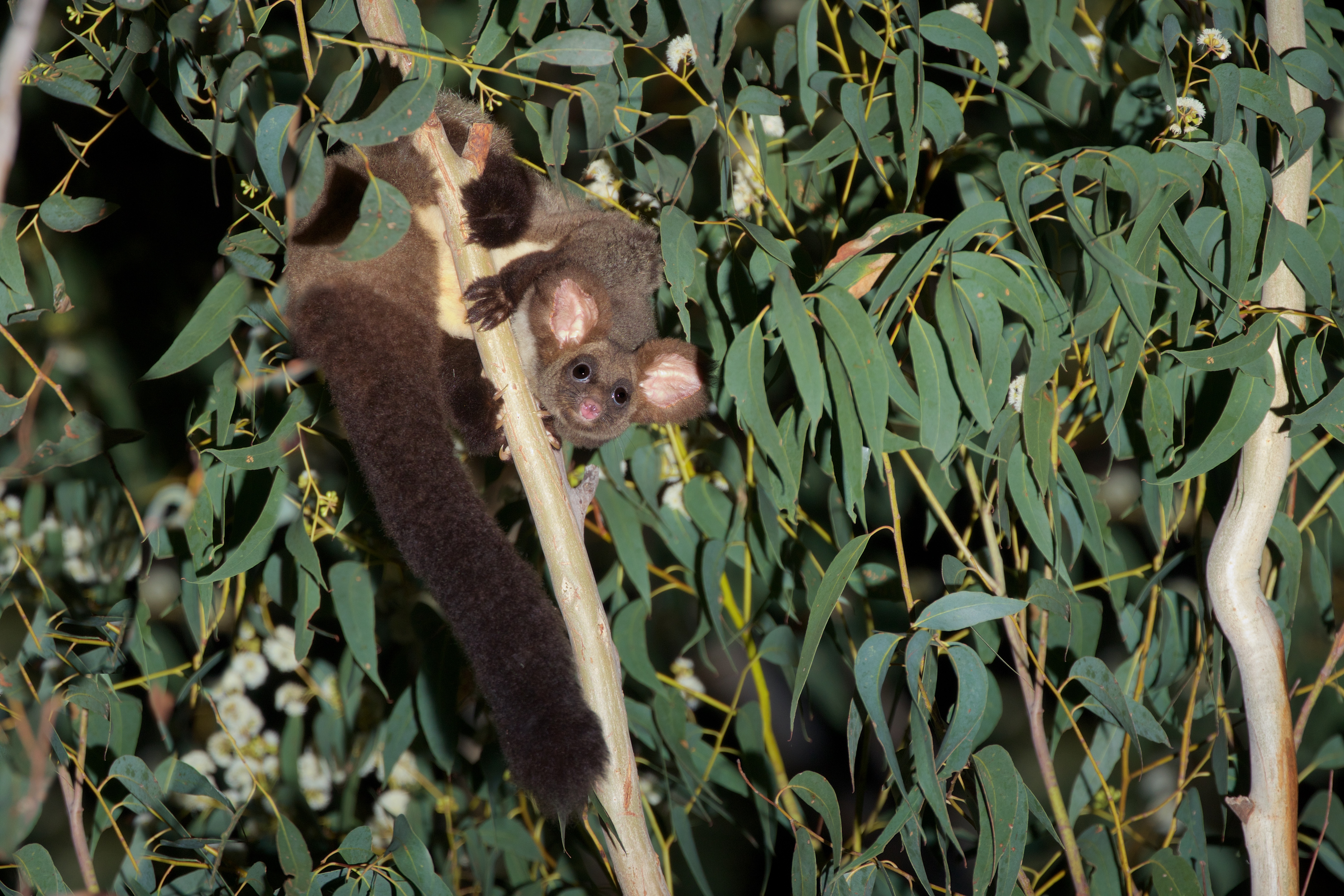
Threatened Greater Glider, Federally listed on the EPBC Act which logging receives special exemption through the RFAs photo by Caleb McIrea
''Last year the Victorian state government rolled over short-term RFAs in order to continue the archaic 20-year agreements under the guise of ‘modernisation’, but there is nothing ‘modern’ about the continued exemption. The review included submissions and community consultation across Victoria. As a result of the consultation a report was released which revealed that protecting native forests from logging was identified by the majority of respondents as being the most important way of improving forests for all Victorians. After 20 years of the contracts, the ‘modern’ view is that they should be scrapped, but the Victorian and Federal governments will continue to give the logging industry special exemption from Federal laws for another decade.''
A scientific advisory panel has been created to make scientific recommendations and assessments on the RFAs, one of the key recommendations is a reassessment of the Comprehensive Adequate and Representative (CAR) reserve system. The CAR reserve system, which is a key part of the exemptions, has been gravely impacted by the bushfires. According to analysis of spatial data of the reserve system in East Gippsland and fire extent mapping, over two thirds of East Gippsland’s parks, reserves, and SPZ’s (Special Protection Zones) which constitute the CAR reserve system are within the fire extent. Of 104 parks managed by Parks Victoria, 34 were entirely burnt out.
.jpg?timestamp=1585999060363)
Map depicting bushfire impacts on East Gippsland reserves. Credit: Fauna and Flora Research Collective (FFRC)
Initial assessments into the impacts of the bushfire were laid bare in a government report:
- Over 62% of Long-footed Potoroo habitat has burnt (EPBC listed)
- Over 40% of Sooty Owl habitat has burnt
- Over 25% of Greater Glider habitat has burnt (EPBC listed)
- 70% Warm temperate rainforests have burnt
- 30% cool temperate rainforests have burnt
''These figures were calculated while the bushfires were still very active, and are only initial indications of the impacts to threatened species and Environmental Vegetation Communities (EVCs). The Federal government has also released a list of provisional species which need urgent action and management plans. They acknowledge that threatened species are in a dire state following the fires and require immediate protection measures, but are signing off on agreements that allow logging of their habitat for the next decade. This is an appalling and unacceptable response to the bushfires.'' the Goongerah Environment Centre states.
In November last year the Victorian Labor government announced protection for 96,000 hectares of forest across Victoria. These forests were designated as ‘Immediate Protection Areas (IPAs) for the threatened Greater Glider. Based on an analysis of Victorian government spatial data that depicts the extent of the IPAs and mapping of the extent of fire impacted forests in East Gippsland, approximately 90% or of recently protected forest within the East Gippsland IPA is now burnt, including the ancient forests of Kuark, one of the most heavily impacted areas. Areas that were set aside for protection have burnt, and now the exemptions will allow logging in some of the last remaining critical unburnt habitat.
''Under the dodgy agreements the last remaining fragments of unburnt forests in East Gippsland will continue to be logged. These areas are crucial for the recovery of threatened species and urgently need protection. You can take action by emailing Premier Daniel Andrews here.'' the group says
''The Victorian and Federal governments have rolled over these 10-year agreements with no consideration of the impacts of the bushfires, which are still yet to be fully understood or assessed. Allowing logging to continue to be exempt from Federal environment laws will spell disaster for fire-affected threatened species across Victoria. The RFAs have fuelled a massive decline in wildlife and biodiversity, and now that's set to continue for another decade. But threatened species are running out of time.
Renewal of the exemptions is a blatant disregard of the impacts of the recent bushfires on threatened species habitat and is in direct contravention of the purpose of the review. While we are experiencing an unprecedented health crisis due to COVID-19, governments are sneaking through laws which will have lasting detrimental impacts to environmental values across Victoria.''
There is no way to “modernise” these archaic agreements, they exist solely to give the logging industry special exemption from Federal Environment laws. Over 66% of East Gippsland’s reserve system is within the fire extent. Every patch of forest that’s left in East Gippsland should be protected in light of the devastating fires and these agreements left to expire.
The bushfires have wreaked havoc on forests and wildlife in East Gippsland. The Victorian government cannot continue to ignore calls from scientists and Victorian communities to scrap the exemption for the logging industry. Given so much of the reserve system has burnt, its likely the agreements won't even be legal.
Environmental Justice Australia (EJA) have released a detailed report about the failure of the RFAs. They say; "The consequences of the fires and the impact on CAR reserves also raise legal issues in relation to whether the agreements continue to be binding, whether RFAs are legally valid, and whether exemptions to the Environment Protection and Biodiversity Act 1999 founded on RFAs continue to apply."
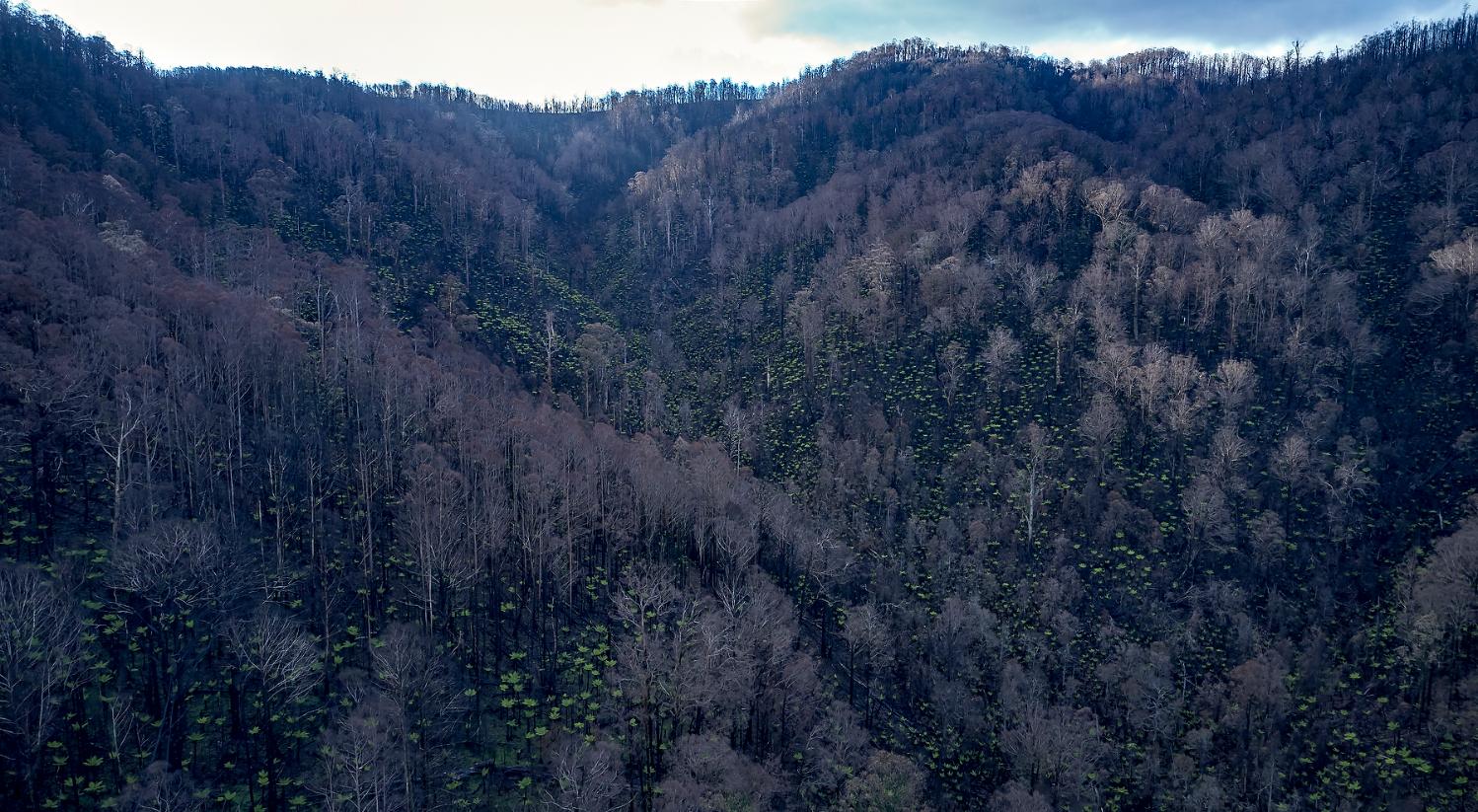
Fire sensitive rainforest gullies which may never recover, Kuark East Gippsland - Goongerah Environment Centre photo
Natural Resources Commission Report On Land Management
March 31, 2020: NSW Department of Planning, Industry and Environment
In 2019 the NSW Government commissioned advice from the Natural Resources Commission about the land management and biodiversity conservation laws.
The NSW Government has received the Commission's report, Land management and biodiversity conservation reforms, final advice on a response to the policy review point.
The NSW Government’s response to the report recommendations:
Recommendations Government response
1. If the implementation of the Native Vegetation Regulatory (NVR) Map remains a NSW Government priority, Environment, Energy and Science Group (EES) implement a staged release of the Native Vegetation Regulatory Map:
1.1 The first stage should involve the immediate release of all categories of the map for woody vegetation-dominant landscapes on a region-by-region basis. This needs to be supported by processes to improve map accuracy, including a process to resolve disagreements on map accuracy that remain following EES’s normal appeal process that is overseen by an independent body.
1.2 The second stage should involve the release of all categories of the map for native grassland-dominant landscapes, once there is more confidence in the accuracy of the mapping of native grassland.
Noted
2. The NSW Government strengthen compliance frameworks by:
2.1 Reviewing the roles, responsibilities and resourcing for monitoring and enforcing compliance with certifications and notifications to clear and set asides under the Land Management (Native Vegetation) Code.
Supported - LLS will review the roles, responsibilities and resourcing for monitoring and compliance with certificates and notifications.
2.2 Developing clear processes to monitor and report on compliance with certifications and notifications to clear and set asides under the Land Management (Native Vegetation) Code. Monitoring and reporting processes should be developed with consideration of best practice principles, including ensuring monitoring can identify incidents of non-compliance and compliance risks in a timely way.
Supported - LLS will consider and develop appropriate processes to monitor and report on compliance with certifications and notifications under the Land Management (Native Vegetation) Code
2.3 Reviewing the drivers of high rates of unexplained clearing and address identified issues.
Supported - EES and LLS will work collaboratively to identify and review drivers of unexplained clearing and address identified issues.
2.4 Developing processes to ensure six monthly monitoring and reporting of unexplained clearing as part of the trigger framework.
Supported - Government supports the development of a process to allow for the monitoring of unexplained clearing.
3. The NSW Government undertake an immediate review of Part 3 (pasture expansion) of the Land Management (Native Vegetation) Code to address risks to biodiversity values state-wide resulting from high rates of certifications and notifications to clear under this part of the Code.
Supported in principle - A review of Part 3 (pasture expansion) of the Land Management (Native Vegetation Code) will be included in the three year review.
4. The NSW Government replace the existing policy review trigger with the immediate implementation of the Commission’s proposed trigger framework.
Trigger 1: Policy implementation: That all core policies of the reform are operational within 18 months of commencement of reforms
- Land Management (Native Vegetation) Code
- NVR Map
- Biodiversity Conservation Investment Strategy
- Private Land Conservation Agreements
- Single measure of assessing biodiversity value under the Biodiversity Offsets Scheme
- Coordinated reform specific Monitoring, evaluation and reporting (MER) framework
Trigger 2: Compliance: Annual areas of unexplained clearing should not exceed pre-reform average (6,350 ha/annum) (EES[lead]/LLS)
Trigger 3: Biodiversity - state wide: Annualised combined area of set asides and conservation agreements is less than two times the area approved for clearing (certification and notifications under Parts 3-6 of the code) (LLS/BCT).
Trigger 4: Biodiversity – regional: Using a ‘traffic-light’ risk rating system, LLS regional risk to biodiversity from clearing under the reforms exceeds ‘high risk’ thresholds: The risk rating system considers the area of land approved to be cleared and area of set asides in each LLS region. (LLS)
Trigger 5: Socioeconomic: State-wide investment in conservation agreements falls below 80% of budget (BCT)
Trigger 6: Code clearing: Reported for consideration without threshold – cumulative area approved to clear under Parts 3 – 6 of the code by ha (LLS)
Supported in principle - A new trigger framework will be considered by the Ministers responsible for the Biodiversity Conservation Act and the Local Land Services Act
5. The Environment, Energy and Science Group, Local Land Services and the Biodiversity Conservation Trust provide a quarterly report on the status of triggers to the Cluster Ministers Group for the Planning, Industry and Environment Cluster.
Supported in principle - Six monthly reporting on triggers and other key indicators will be provided to a Departmental governance group that will be established to oversee implementation of the LMBC reforms and report to Ministers responsible for the Biodiversity Conservation Act and the Local Land Services Act (see response to recommendation 8).
6. Previous reporting on triggers to Cabinet is replaced by reporting on an annual or exceptional basis if thresholds are exceeded to ensure Cabinet remains informed.
Noted - See response to 5.
7. If a coordinated, reform specific MER program remains a NSW government priority, the NSW Government implement an overarching MER framework within six months that is informed by the Commission’s proposed MER framework so that sufficient data is collected to inform the three- and five-year reviews to the best possible extent.
Supported in principle - The Government supports sufficient monitoring to occur to enable reporting to be done in response to recommendation 5 above.
8. The Secretary of the Planning, Industry and Environment Cluster establish an overarching steering committee (with independent Chair) comprised of relevant agencies to oversee coordination and implementation across the whole reform, including:
- the implementation of the trigger and MER frameworks
- alignment of strategic priorities, including conservation investment
- responses to emerging issues
- landholder engagement and capacity building
- data and information sharing.
Supported in principle - The Department will establish a governance group to oversee the LMBC reforms and report to the Ministers responsible for the Biodiversity Conservation Act and the Local Land Services Act. The group will:
- monitor key risks
- oversee the three-year review of the reforms
- prepare for the five-year statutory review of the Biodiversity Conservation Act 2016 and Part 5A of the Local Land Services Act 2013.
Terms of Reference will be finalised by the governance group for Ministers’ consideration and approval.
8.1 The steering committee should have an independent chair appointed by the Secretary (such as a representative of the Secretary’s Office).
Not supported - The governance group will be co-chaired by the Coordinator General, Environment, Energy and Science and Coordinator General, Regions, Industry, Agriculture and Resources and report directly to the Ministers responsible for the Biodiversity Conservation Act and the Local Land Services Act.
9. As part of the three-year review, the NSW government should consider:
9.1 Barriers to landholder engagement with the native vegetation panel. This review should include the role and responsibilities of the Panel under the Local Land Services Act 2013 and potential opportunities to increase the options available to the NV panel to assist with applications that fall outside of the Code.
Supported - A review of the barriers to landholder engagement with the Native Vegetation Panel (including issues relating to the Biodiversity Offsets Scheme) will be included in the three-year review.
9.2 Whether adequate processes are in place for agencies and the broader community to nominate areas to be recommended by EES for declaration as an Area of Outstanding Biodiversity Value (AOBV).
Noted
Reminder Of Closed Areas: Ku-Ring-Gai Chase National Park Visitor Areas And Facilities Are Closed
Applies from Tue 31 Mar 2020, 10.41am. Last reviewed: Fri 03 Apr 2020: NPWS
Many high visitation areas and facilities within Ku-ring-gai Chase National Park are closed until further notice to protect the health and safety of our visitors and staff. The closed areas include:
- Bobbin Head Information Centre
- All large picnic shelters
- All picnic and barbecue facilities (including picnic tables)
- All playgrounds
- Brooklyn Dam campsites
- Barrenjoey Headland and Barrenjoey Lighthouse
Berowra track remains closed between Apple Tree Bay and the intersection of Mount Ku-ring-gai track until further notice, while staff fix extensive storm damage.
The closure of toilets and other facilities will be decided on a case-by-case basis, with necessary site assessments considering the management of health and safety risk to visitors and staff, as well as available resourcing to maintain facilities. Access to sanitation products and running water cannot be guaranteed. We recommend bringing hand soap, hand wipes and toilet paper with you to maintain good hygiene as advised by the NSW Government.
If you wish to exercise in a national park, you should choose a park close to your home. Visitors are reminded that non-essential travel is currently not permitted. If your planned visit is for a purpose other than exercise, you should reconsider your plans as you may be in breach of the current public health orders. If you arrive at a national park or other public space and it is too crowded to practice social distancing, it is your responsibility to leave the area. Do not wait to be instructed by NPWS or police.
If you're visiting the park, please bring a card to pay vehicle entry fees.
For more information about closures, call the NPWS Contact Centre on 1300 072 757, the NPWS North Western Sydney area office on 02 8448 0400 or the NPWS Sydney North area office on 02 9451 3479.
Penalties apply for non-compliance. Please check our COVID-19 update for further information.
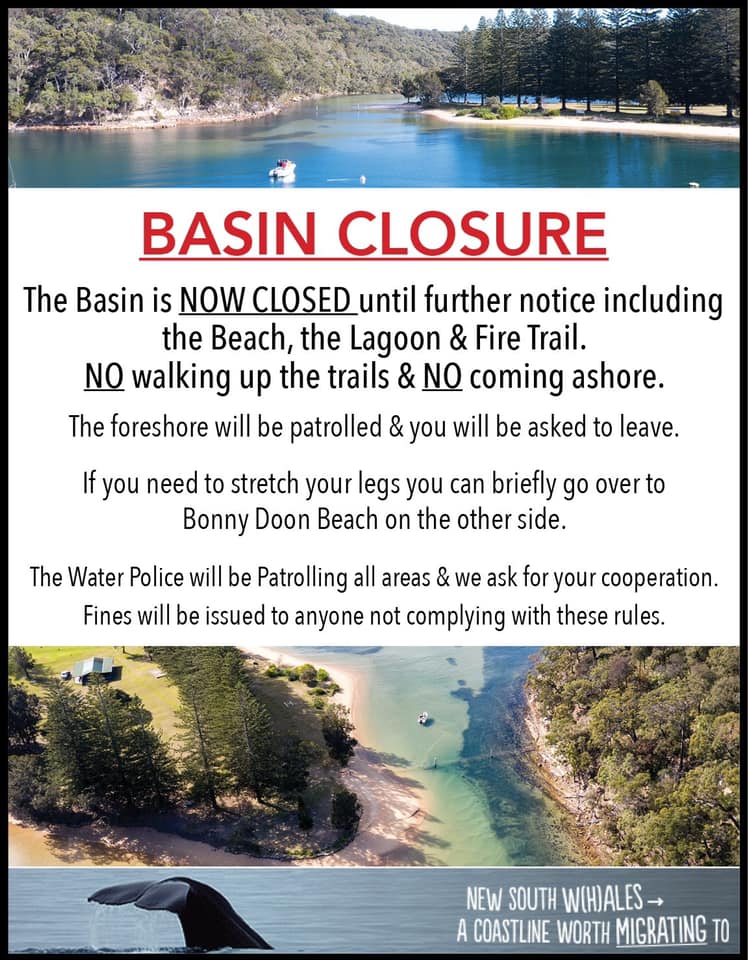
Birding At Home
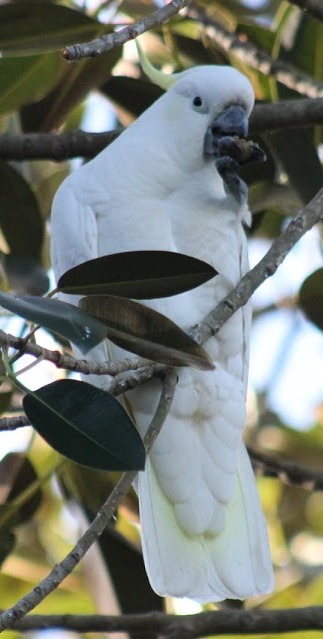 As COVID-19 causes so much heartbreak and sadness around the world, I'm inspired by the bravery of our frontline workers and the spirit of cooperation as we all work together to get through this.
As COVID-19 causes so much heartbreak and sadness around the world, I'm inspired by the bravery of our frontline workers and the spirit of cooperation as we all work together to get through this.
I can assure you BirdLife Australia is continuing its fight to stop extinctions and protect nature, even if many of us are doing this from our own homes. We need you now more than ever.
Thank you to everyone for staying at home as much as possible to stop the spread of the virus and save lives. I know self-isolation can be challenging and stressful at times so what we need right now is nature.
I am so grateful that no matter where you live, you can still see birds and take comfort from them.
Please visit our new Birding at Home page to find out how you and your household can continue to enjoy the beauty of our feathered friends.
You'll find activities to occupy kids while our movements are restricted, links to our Autumn Birds in Backyards survey and Bird Finder, and information on how you can act to protect birds forever.
To help everyone who is now Birding at Home, we are also kicking off a regular live series on Facebook where our bird experts will be taking questions and talking about what we love best - birds.
The first event will be Backyard Birding for Beginners, hosted by Sean Dooley on Thursday April 9th. Even if you are an expert birder, I encourage you to join in for a chat – and please spread the word to all the bird and nature lovers in your life. Sean is also keen to answer your backyard birding questions – so if you've got a query, get involved!
Event details:
BirdLife Australia Facebook
Backyard Birding for Beginners with Sean Dooley
Thursday April 9
12:00pm AEST / 11:30am ACST / 10:00am AWST
These are difficult times and it's important to support each other. We hope our new resources will help you get through these unprecedented times.
Paul Sullivan, CEO
BirdLife Australia
P.S. We'll be having new bird experts every week to talk about a new topic, including Amanda Lilleyman in the NT on shorebirds and Holly Parsons to talk about bird friendly gardens. Make sure you have liked us on Facebook to get notifications!
New Department Of Regional NSW To Take On Urgent Needs Of The Bush
April 2nd, 2020: NSW Department of Planning, Industry and Environment
The NSW Government today established the new Department of Regional NSW to better coordinate support for communities, businesses and farmers in the bush that have endured drought, bushfire and flood and now face the impact of the COVID-19 pandemic.
Deputy Premier and Minister for Regional NSW John Barilaro said the department will bring together Primary Industries, Local Land Services, Resources and Geoscience and regional coordination across government to form a central agency dedicated to regional issues.
“We are urgently responding to the desperate needs of people in the regions and this new agency will work to ensure community wellbeing, resilient economies and strong key regional industries,” Mr Barilaro said.
“We know that the issues faced by the people of Cootamundra are very different to those faced in Coogee and so it is imperative we have a government designed to properly support every corner of this State.
“The COVID-19 pandemic has made a big impact on what has already been a devastating start to 2020, as farmers continue to suffer through the worst drought in recorded history and towns torn apart by bushfires continue to feel the effects months on.
“The new Department of Regional NSW will be a voice in government for people in the bush and will have a laser-like focus on the challenges and opportunities unique to regional communities, helping them to get through hardships many of us have not seen in our time.
“This department will allow a more streamlined response to regional issues as experts in areas such as primary industries, land management, resources, regional development, drought response and bushfire recovery work closer together than ever before.”
Mr Barilaro said the department will drive the delivery of recent bushfire and COVID-19 stimulus and industry recovery packages along with the NSW Government’s drought initiatives, $1.7 billion Regional Growth Fund and $4.2 billion Snowy Hydro Legacy Fund.
“I said that regional communities would get their fair share and to date, we have fulfilled that commitment, from securing billions in funding to the urgent measures we have rolled out for farmers, business owners and families,” Mr Barilaro said.
The Department of Regional NSW will be led by incoming Secretary Gary Barnes, currently the Coordinator General, Regional NSW, Department of Planning, Industry and Environment.
Flows Resume In The Lower Darling River And Temporary Water Restriction Repealed
March 30, 2020
The NSW Department of Planning, Industry and Environment today announced the lifting of the temporary water restriction for the Lower Darling River, now that flows have resumed.
As a result of recent rainfall events across the northern NSW Murray-Darling Basin and subsequent inflows to the Barwon-Darling River system, it is anticipated that 290 to 380 gigalitres (GL) will flow into the Menindee Lakes, with flows starting to enter the lakes on 10 March.
Based on the forecast, there will be enough water captured in the Menindee system to provide connectivity to the Murray and deliver high priority needs, including critical environmental needs along the Lower Darling for at least 12 to 18 months – possibly longer.
The repeal of the temporary water restriction will allow access to remaining water in high security and general security accounts in 2019-20. This will not impact on the ability to supply water for critical needs. It is expected that full allocations for town water, domestic and stock and high security allocations for the rest of this water year will also be announced in the next Water Allocation Statement on Wednesday 1 April 2020.
This is consistent with the approach taken in the northern valleys, where suspensions of carryover water were lifted in the Border Rivers and Upper and Lower Namoi Rivers once 12 months of water for critical needs was available in storage.
Water releases to the Lower Darling River from Menindee Lakes began on Thursday 26 March, commencing at 500 megalitres (ML)/day to a peak of 3,000 ML/day by Sunday. Releases will now be held at 3,000 ML/day for the next 7 days and then reduced by 250 ML/day back to a flow of 300 ML/day. This will create the pulse flow necessary to manage water quality and associated fish risks. These are the first significant flows to occur in the Lower Darling River since 2016.
Although the releases will provide substantial benefits to fish communities in the lower Darling, there is the risk that when flows first enter the refuge pools there may be a short-term risk and resulting fish deaths from the initial turn-over of poor quality water.
Further information about the lifting of temporary water restriction.
Information regarding flows into the Lower Darling River is available on the department’s website.
Please report any fish deaths or observations to the Fishers Watch Phoneline on 1800 043 536.
First Record Of Quolls At Tilbuster, North Of Armidale In 17 Years
April 1, 2020
A chicken thief at Tilbuster north of Armidale has proved to be the first local sighting of threatened spotted-tailed quoll for 17 years.
NSW National Parks and Wildlife Service Saving our Species Officer Adam Fawcett said that this was the first confirmed sighting in the area, north of Armidale since 2003.
“A local resident between Mt Duval and the Devils Pinch made the surprising find after setting up a camera to catch what he thought would be a feral cat.
"Chickens had been lost regularly in over a few weeks, so he put out an infra-red motion sensor camera to see how the animal was getting into the chicken pen and, to his surprise, captured images of a spotted-tailed quoll.
“The resident wasn’t concerned with the presence of the quoll - a simple plugging of the hole in his netting stopped the quoll raiding the chook pens, Mr Fawcett said.
Spotted-tailed Quolls are listed as a Vulnerable species in NSW. Large populations are known to occur throughout the gorge areas east of Armidale including several national parks such as Oxley Wild Rivers, New England and Guy Fawkes River National Parks and adjacent forested areas.
“Spotted-tailed quolls are the largest native marsupial predator in NSW and while there are scattered historic records in the area north of Armidale, this is the first confirmed record since 2003.
“This is an especially important find given the severe recent drought and its impact on vegetation.
“Threats to spotted-tailed quolls include loss of habitat and being hit by vehicles as they cross roads, but one of the biggest issues is animals being shot or poisoned in response to attacks on domestic chickens and aviaries.
“As demonstrated in this case, it is easy enough to make these structures quoll-proof.
“Securing the spotted-tailed quoll is part of the NSW Saving Our Species program. Surveys are planned to occur later this year across the range of this species in NSW to gain an overall picture of the health of the population in NSW.
“NPWS is always interested in new records of spotted-tailed quolls. Both the NPWS and New England Local Land Services can provide advice on how to improve poultry runs and aviaries to make them quoll-proof if you are having issues with this species at home, “ Mr Fawcett said.
Anybody with records of spotted-tailed quolls or other threatened species can contribute them to the NSW Wildlife Atlas by contacting Environment Line on 1300 361 967 or info@environment.nsw.gov.au. Alternatively, records can be entered direct to the Wildlife Atlas via the online portal.
The Saving our Species program is the NSW Government's commitment to securing the future of the State's threatened plants and animals. To find out more, or to get involved with Saving our Species visit Help save our threatened species.
A major scorecard gives the health of Australia's environment less than 1 out of 10
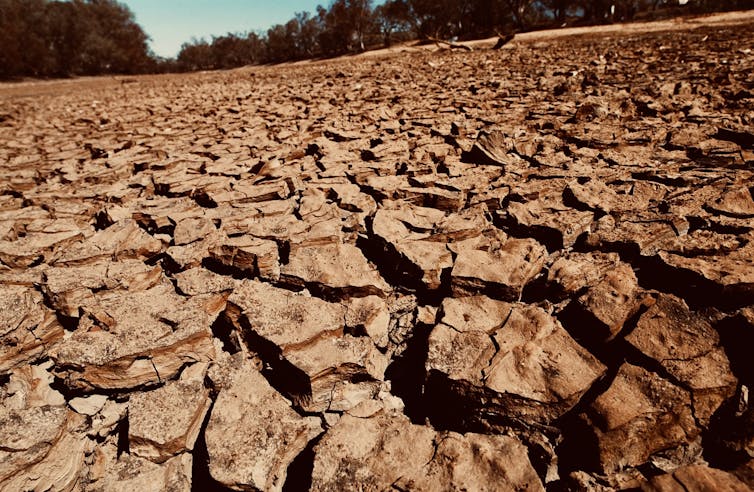
2019 was the year Australians confronted the fact that a healthy environment is more than just a pretty waterfall in a national park; a nice extra we can do without. We do not survive without air to breathe, water to drink, soil to grow food and weather we can cope with.
Every year, we collate a vast number of measurements on the state of our environment: weather, oceans, fire, water, soils, vegetation, population pressure, and biodiversity. The data is collected in many different ways: by satellites, field stations, surveys and so on.
We process this data into several indicators of environmental health at both national and regional levels.
The report for 2019, released today, makes for grim reading. It reveals the worst environmental conditions in many decades, perhaps centuries, and confirms the devastating damage global warming and mismanagement are wreaking on our natural resources.
Immediate action is needed to put Australia’s environment on a course to recovery.
Environment Scores In The Red
From the long list of environmental indicators we report on, we use seven to calculate an Environmental Condition Score (ECS) for each region, as well as nationally.
These seven indicators – high temperatures, river flows, wetlands, soil health, vegetation condition, growth conditions and tree cover – are chosen because they allow a comparison against previous years. In Australia’s dry environment, they tend to move up and down together, which gives the score more robustness. See the interactive graphic below to find the score for your region.
Nationally, Australia’s environmental condition score fell by 2.3 points in 2019, to a very low 0.8 out of ten. This is the lowest score since at least 2000 – the start of the period for which we have detailed data.
Condition scores declined in every state and territory. The worst conditions were seen in the Northern Territory (0.2 points), New South Wales (0.3 points) and Western Australia (0.4 points), with the latter also recording the greatest decline from the previous year (-5.7 points).
What is most striking is that almost the entire nation suffered terrible environmental conditions in 2019. In each case, the changes can be traced back to dry, hot conditions. Only parts of Queensland escaped the drought.
Comparing local government areas, the worst conditions occurred in Armidale and Gwydir in northern NSW. In contrast, Winton and Townsville in Queensland escaped the overall poor conditions, thanks to the beneficial impact of high rainfall early in the year – although those same events also caused floods killing around 600,000 livestock.
Extreme Drought And Extreme Heat
So what exactly happened in Australia in 2019 to cause such widespread environmental damage? There were several causes.
Across most of Australia, the environment was already reeling from poor conditions in 2018. Also, cool temperatures in the Indian Ocean delayed the onset of the monsoon in northern Australia and reduced the flow of moisture to the rest of the continent, creating hot and dry conditions. Average rainfall was a mere 229 mm across the continent, the lowest in more than 119 years and probably longer than that.
The heat was also extraordinary. The average number of days above 35°C across the country was 36% more than the average for the 19 years prior.
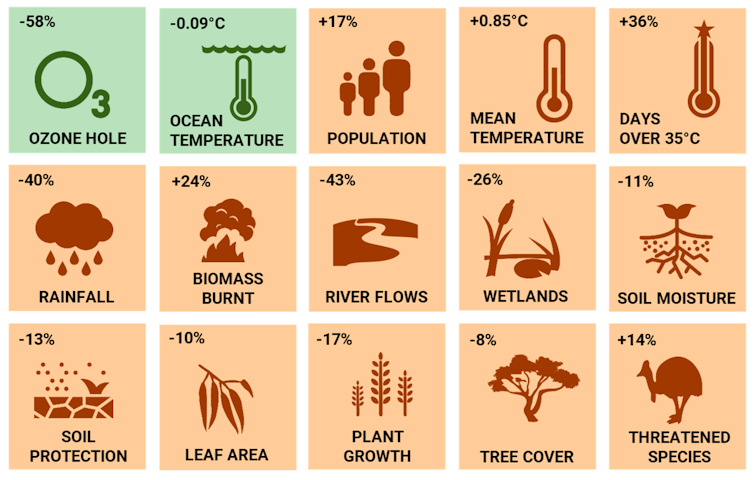
In eastern Australia, arid and hot conditions pushed farmers and ecosystems deeper into drought. In many regions, dryness and declining protection from wind erosion created the worst soil conditions in at least 20 years. Consequences included several dust storms and widespread dieback of forests, especially in NSW.
The severe drought also affected inland water systems, especially the Darling River and its tributaries. Town water supply reservoirs ran out of water, the rivers stopped flowing, and the heat turned the remaining pools into death traps for fish.
Other rivers in northwest Australia, southeast Queensland and northeast NSW also saw their worst flows in 20 years.
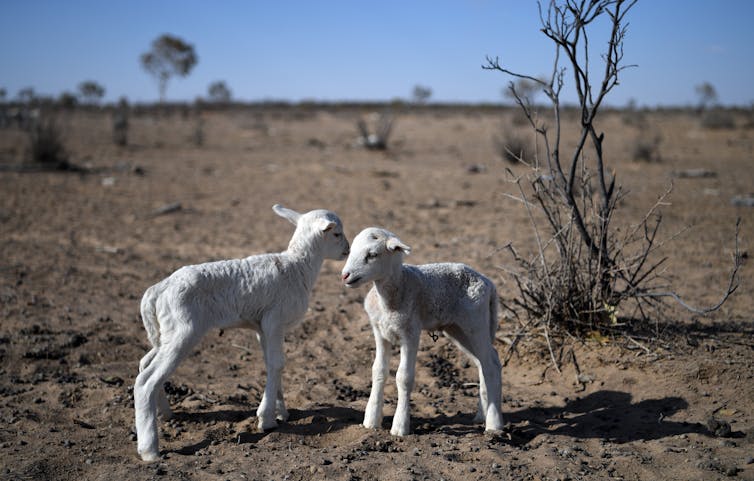
Unprecedented Fires
Of course, 2019 will be remembered as the year of unprecedented bushfires. Nationally, the total area burnt was not unusual, not even when the fires of early 2020 are included. But this is only because fire activity was much below average in northern Australia, where ongoing dry conditions left little vegetation to burn.
The extent of forest fires last year was unprecedented, however. As predicted well in advance, the tinder-dry forests in eastern Australia provided the fuel for a dramatic fire season that started in September. Between then and the first month of 2020, vast areas of forest in New South Wales, eastern Victoria, Kangaroo Island and the Australian Capital Territory went up in flames.
The fires destroyed more than 3,000 homes and directly killed 33 people. Indirectly, the most hazardous air quality in living memory created major but poorly known health impacts. The fires also damaged the reliability of drinking water supplies.
Read more: Yes, the Australian bush is recovering from bushfires – but it may never be the same
The ecological damage was also profound. Fires raged through ecosystems poorly adapted to fire, from rainforests in tropical Queensland to alpine vegetation in Tasmania and the Snowy Mountains of NSW. It remains to be seen whether they can recover. Across NSW, 35% of rainforests were turned to cinders.
About 191 species of animals and plants saw more than one-third of their living area burnt, among them 52 species that were already threatened. Thankfully, the last remaining stands of the prehistoric Wollemi pine and the rare Nightcap Oak were saved.
Even before the fires, 40 plant and animal species were added to the threatened list in 2019, bringing the total to 1890. Following the fires, more species are likely to be added in 2020.
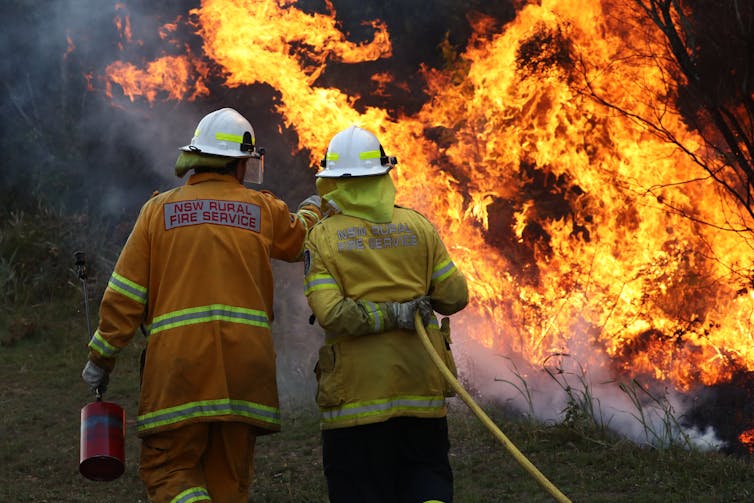
We’re Not Doomed Yet
Last year was neither an outlier nor the “new normal” – it will get worse.
Greenhouse gas concentrations continued to increase rapidly in 2019, causing the temperature of the atmosphere and oceans to soar. Australia’s population also continued to grow quickly and with it, greenhouse gases emissions and other pollution, and our demand for land to build, mine and farm on.
Whether we want to hear it or not, last year represented another step towards an ever-more dismal future, unless we take serious action.
Read more: Here's what the coronavirus pandemic can teach us about tackling climate change
The current coronavirus pandemic shows that as individuals, and collectively, we can take dramatic action once we acknowledge the urgency of a threat. By comparison, addressing environmental decline will cost less, whereas the long-term costs of not acting will be far greater.
There is much we can do. In the short term, we can help our natural ecosystems recover from the drought and fires. Government agencies and land owners can cull and manage invasive species in fire-affected areas - from weeds, to foxes, cats and feral horses - and stop damaging logging in fire-affected areas.
Individuals can do their bit. We can donate money or time to organisations committed to helping ecosystems recover. Record what you see on bushwalks to help environmental managers monitor and assist ecological recovery.
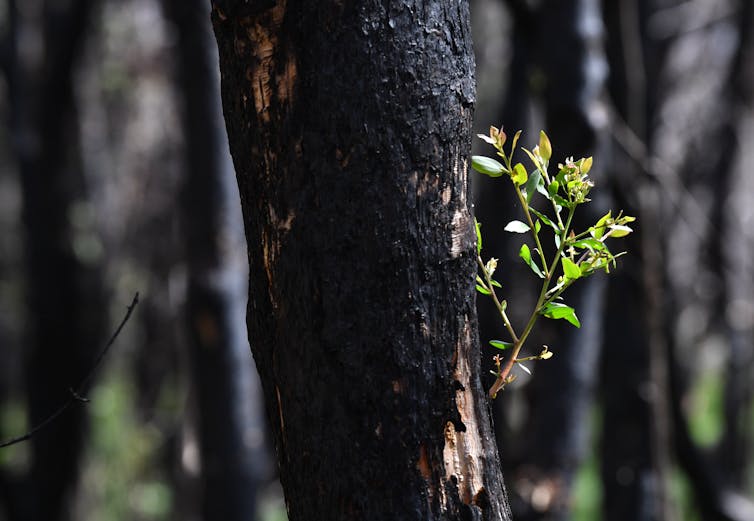
But the damage of climate change is not limited to natural environments. We must get serious about curbing greenhouse emissions. Humanity has the tools, technology and ingenuity to do it and Australia, one of the countries worst affected by climate change, should lead the world.
Beyond that, individuals can also make a contribution: recycle and reuse rather than buy new, choose low-emission and renewable energy technology and reduce waste – it can save money even now. Let governments and politicians hear your voice. Try to convince friends and family that things need to change.
In the long term, we must find a more balanced relationship with the natural world, understanding that our own survival will depend on it.
The full report and webinar are available here.
Read more: Lots of people want to help nature after the bushfires – we must seize the moment ![]()
Albert Van Dijk, Professor, Water and Landscape Dynamics, Fenner School of Environment & Society, Australian National University; Luigi Renzullo, Senior Research Fellow, Australian National University; Marta Yebra, Senior lecturer, Australian National University, and Shoshana Rapley, Research assistant, Australian National University
This article is republished from The Conversation under a Creative Commons license. Read the original article.
While we fixate on coronavirus, Earth is hurtling towards a catastrophe worse than the dinosaur extinction
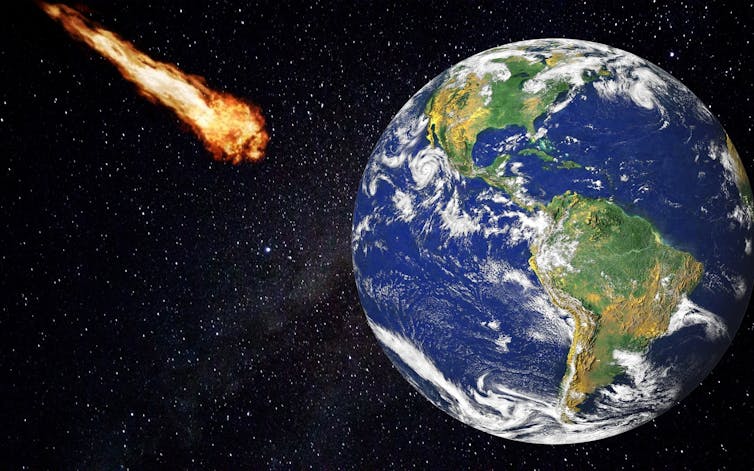
At several points in the history of our planet, increasing amounts of carbon dioxide in the atmosphere have caused extreme global warming, prompting the majority of species on Earth to die out.
In the past, these events were triggered by a huge volcanic eruption or asteroid impact. Now, Earth is heading for another mass extinction – and human activity is to blame.
I am an Earth and Paleo-climate scientist and have researched the relationships between asteroid impacts, volcanism, climate changes and mass extinctions of species.
Read more: Here's what the coronavirus pandemic can teach us about tackling climate change
My research suggests the current growth rate of carbon dioxide emissions is faster than those which triggered two previous mass extinctions, including the event that wiped out the dinosaurs.
The world’s gaze may be focused on COVID-19 right now. But the risks to nature from human-made global warming – and the imperative to act – remain clear.
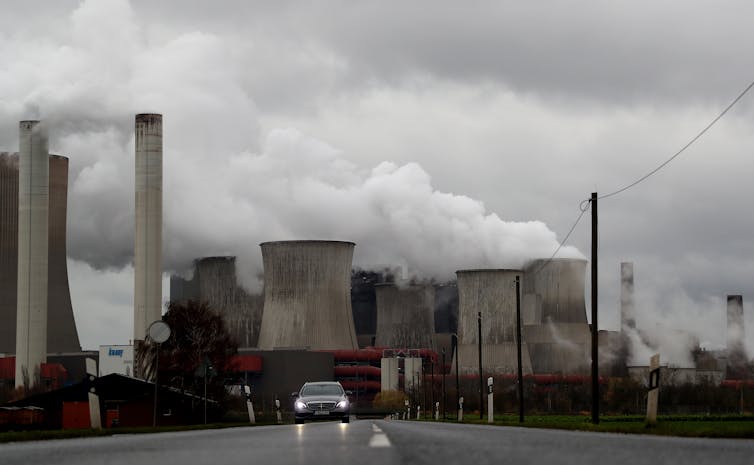
Past Mass Extinctions
Many species can adapt to slow, or even moderate, environmental changes. But Earth’s history shows that extreme shifts in the climate can cause many species to become extinct.
For example, about 66 million years ago an asteroid hit Earth. The subsequent smashed rocks and widespread fires released massive amounts of carbon dioxide over about 10,000 years. Global temperatures soared, sea levels rose and oceans became acidic. About 80% of species, including the dinosaurs, were wiped out.
And about 55 million years ago, global temperatures spiked again, over 100,000 years or so. The cause of this event, known as the Paleocene-Eocene Thermal Maximum, is not entirely clear. One theory, known as the “methane burp” hypothesis, posits that a massive volcanic eruption triggered the sudden release of methane from ocean sediments, making oceans more acidic and killing off many species.
So is life on Earth now headed for the same fate?
Comparing Greenhouse Gas Levels
Before industrial times began at the end of the 18th century, carbon dioxide in the atmosphere sat at around 300 parts per million. This means that for every one million molecules of gas in the atmosphere, 300 were carbon dioxide.
In February this year, atmospheric carbon dioxide reached 414.1 parts per million. Total greenhouse gas level – carbon dioxide, methane and nitrous oxide combined – reached almost 500 parts per million of carbon dioxide-equivalent
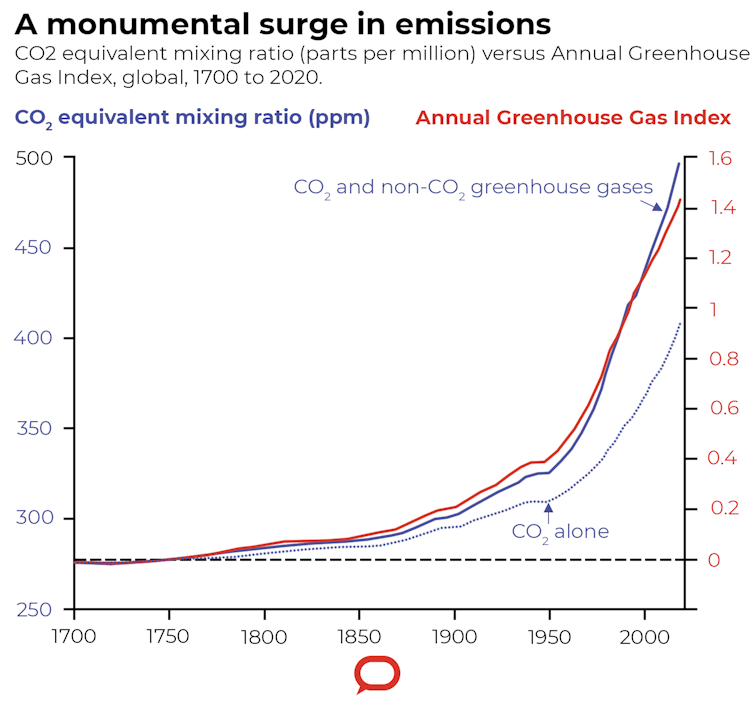
Carbon dioxide is now pouring into the atmosphere at a rate of two to three parts per million each year.
Using carbon records stored in fossils and organic matter, I have determined that current carbon emissions constitute an extreme event in the recorded history of Earth.
My research has demonstrated that annual carbon dioxide emissions are now faster than after both the asteroid impact that eradicated the dinosaurs (about 0.18 parts per million CO2 per year), and the thermal maximum 55 million years ago (about 0.11 parts per million CO2 per year).
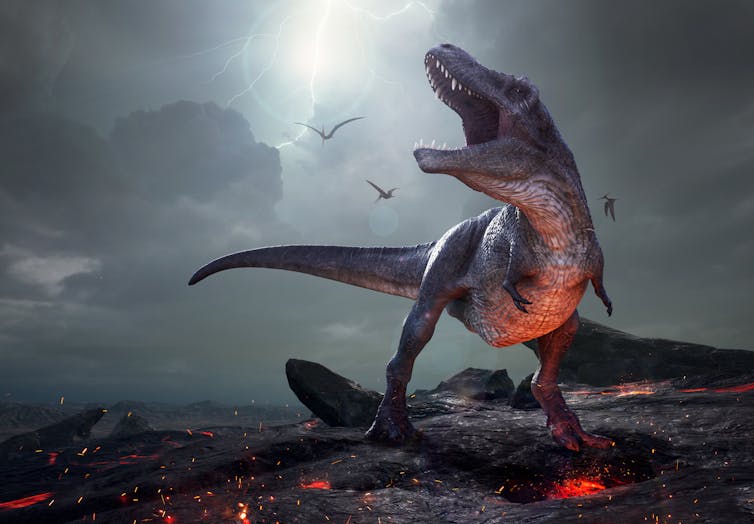
The Next Mass Extinction Has Begun
Current atmospheric concentrations of carbon dioxide are not yet at the levels seen 55 million and 65 million years ago. But the massive influx of carbon dioxide means the climate is changing faster than many plant and animal species can adapt.
A major United Nations report released last year warned around one million animal and plant species were threatened with extinction. Climate change was listed as one of five key drivers.
The report said the distributions of 47% of land-based flightless mammals, and almost 25% of threatened birds, may already have been negatively affected by climate change.
Read more: Curious Kids: What effect did the asteroid that wiped out the dinosaurs have on plants and trees?
Many researchers fear the climate system is approaching a tipping point - a threshold beyond which rapid and irreversible changes will occur. This will create a cascade of devastating effects.
There are already signs tipping points have been reached. For example, rising Arctic temperatures have led to major ice melt, and weakened the Arctic jet stream – a powerful band of westerly winds.
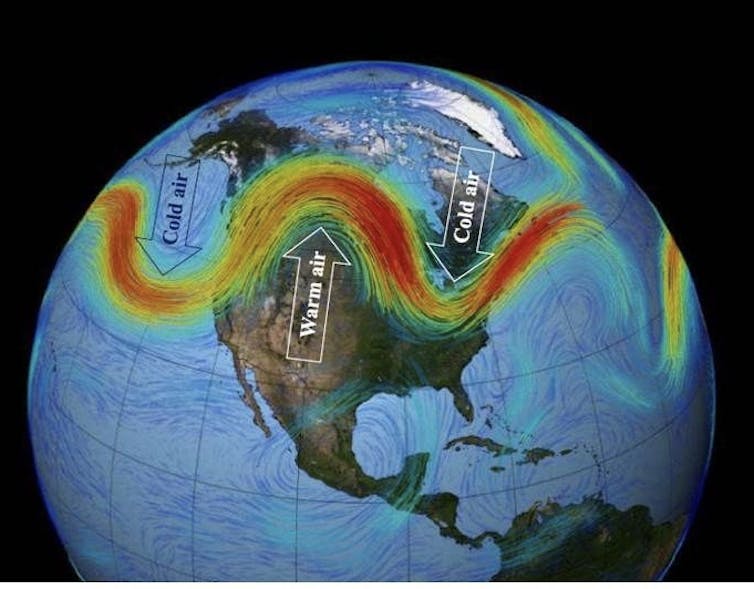
This allows north-moving warm air to cross the polar boundary, and cold fronts emanating from the poles to intrude south into Siberia, Europe and Canada.
A shift in climate zones is also causing the tropics to expand and migrate toward the poles, at a rate of about 56 to 111 kilometres per decade. The tracks of tropical and extra-tropical cyclones are likewise shifting toward the poles. Australia is highly vulnerable to this shift.
Uncharted Future Climate Territory
Research released in 2016 showed just what a massive impact humans are having on the planet. It said while the Earth might naturally have entered the next ice age in about 20,000 years’ time, the heating produced by carbon dioxide would result in a period of super-tropical conditions, delaying the next ice age to about 50,000 years from now.
During this period, chaotic high-energy stormy conditions would prevail over much of the Earth. My research suggests humans are likely to survive best in sub-polar regions and sheltered mountain valleys, where cooler conditions would allow flora and fauna to persist.
Earth’s next mass extinction is avoidable – if carbon dioxide emissions are dramatically curbed and we develop and deploy technologies to remove carbon dioxide from the atmosphere. But on the current trajectory, human activity threatens to make large parts of the Earth uninhabitable - a planetary tragedy of our own making.
Read more: Anatomy of a heatwave: how Antarctica recorded a 20.75°C day last month ![]()
Andrew Glikson, Earth and paleo-climate scientist, Australian National University
This article is republished from The Conversation under a Creative Commons license. Read the original article.
Honeyeaters Send Lightning-Fast Warning Signals
March 31, 2020
New Holland honeyeaters are experts at sounding the alarm when there's danger, according to new research from biologists at The Australian National University (ANU) and the University of Cambridge.
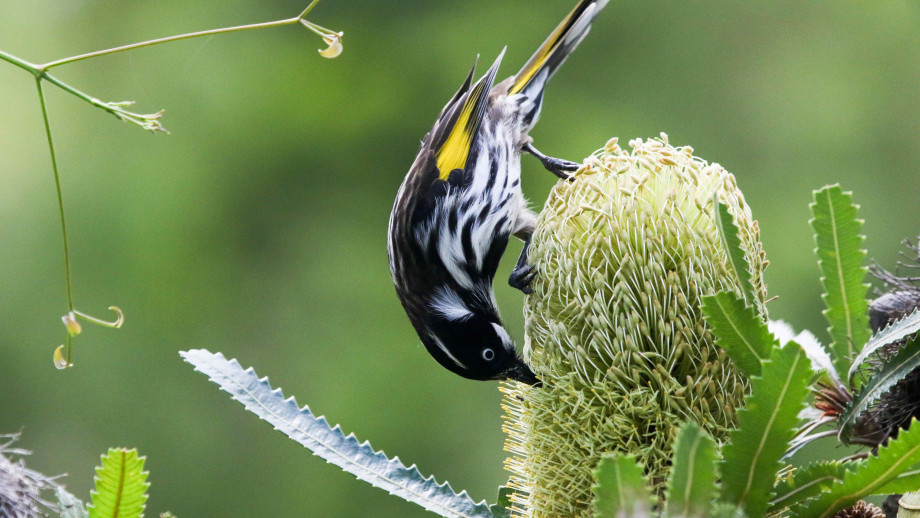
Honeyeater Feeding - photo by Jessica McLachlan
Study authors, Dr Jessica McLachlan and Professor Rob Magrath, found honeyeaters can spread the word in the blink of an eye, using a two-stage alarm.
It's particularly effective when they are threatened by fast-moving birds of prey.
"When a hawk is swooping down, its target has only a fraction of a second to flee to cover - a split second can make the difference between life and death," Dr McLachlan said.
"But animals often signal urgent danger using repeated notes, which makes sure others hear the warning but it takes a long time to deliver.
"So there's a problem. How to send a lightning-fast message in a long call?"
New Holland honeyeaters solve this problem elegantly. They 'front-load' information about urgency into the first note of their alarm call, so other honeyeaters can respond quickly.
The clever honeyeaters follow this up with more notes to reinforce the message and signal how long to remain hidden.
"They use a long call, with lots of notes, to make sure the message is heard," Professor Magrath said. "And the more notes, the more urgent the danger.
"But they also modify the first note to indicate if it's necessary to take immediate cover. So it's a two-part message that is quick, reliable and informative."
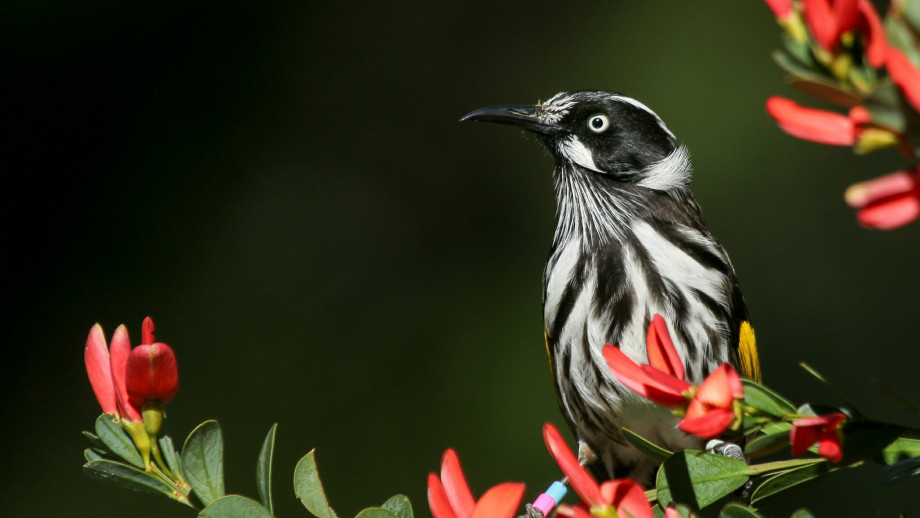
Honeyeater on Alert - photo by Jessica McLachlan
The technique is so effective the authors expect to see other species adopt it.
"Many other species modify alarm calls as the threat increases, but there is surprisingly little known about how fast they convey the message," Professor Magrath said.
The researchers conducted their study in Canberra's Australian National Botanic Gardens over a period of several years.
"These birds live in the Gardens and are used to having people around. This helped us to record natural interactions with their predators, such as sparrowhawks and currawongs, and to video the honeyeaters' responses to different alarm calls," Professor Magrath said.
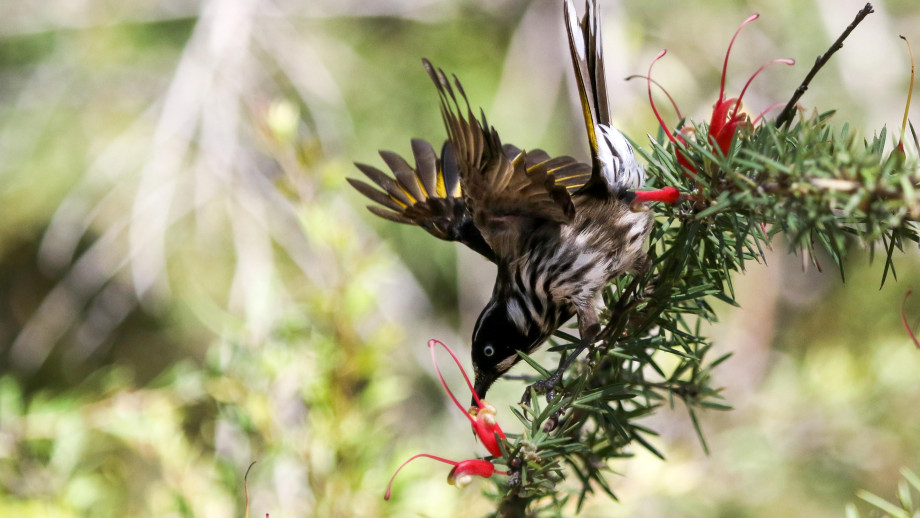
Honeyeater Fleeing - photo by Jessica McLachlan
The research is published in the journal Proceedings of the Royal Society B.
Even If The Parks Are Closed You Can Still Go Google Trekking
A few years ago Pittwater Online shared some great news about the state government working with Google in what is called 'Google Trekker' - our own local MP, Rob Stokes, Member for Pittwater was the State Environment Minister at that time, so it was great to hear about this first-hand from him - he loves the great outdoors!
Back in June 2014 the work began of mapping our National Parks - by actually walking through them with a camera - this is what the ranger walking with the camera looked like - they started with doing 16 parks to begin with:
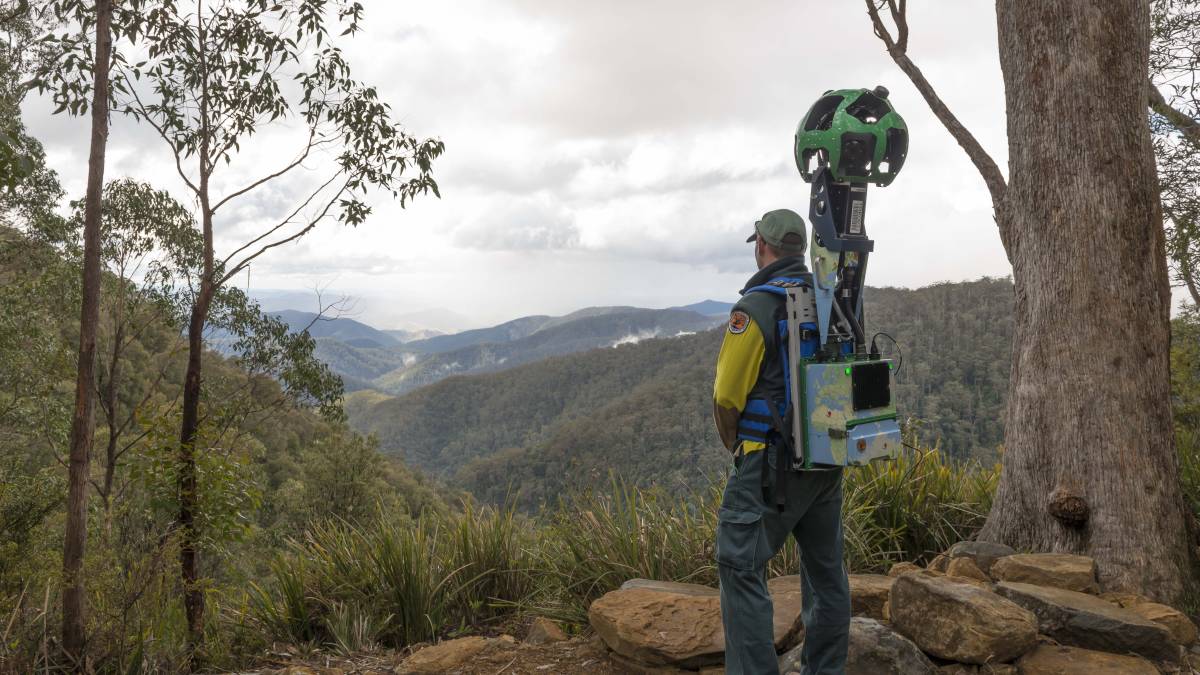
OEH - NPWS photo
Then in November 2014 Environment Minister Rob Stokes launched Google Street View imagery of some of the most picturesque and visited national parks in NSW.
Mr Stokes said the NSW National Parks and Wildlife Service is the first organisation in Australia to be part of the Google program, which sees organisations borrow the Trekker technology to collect imagery of hard to reach places and help map the world.
“NPWS have captured 360-degree imagery of 25 parks from Kosciuszko to Cape Byron, covering over 400 kilometres of walking tracks and 700 kilometres of roads and trails,” Mr Stokes said then.
“This new service means people can scope out walks before they travel, or get a glimpse of places they would otherwise find inaccessible.
“People who have been unable to make it to the bottom of that gorge or the top of that ridge can now see all the sites our national parks have to offer.
"In conjunction with the NSW National Parks website, this imagery will give people another great way to plan their park visits, check walking tracks for suitability and learn about the area beforehand.
“We have a lot to be proud of in NSW with some of the most beautiful and remote places on the planet.
“These maps will ensure people who may not have the ability to walk in some of these popular locations will still have the opportunity to experience our vast natural beauty from their lounge rooms on the other side of the world.”
Basically, Google Trekker allows you to explore our National Parks as though you were on their bush tracks. You can Discover new places with a virtual tour of walking tracks, lookouts and campgrounds on the coast, deep within rainforests, and even in Outback NSW. You can get 360 degree views of these incredible landscapes and go on your own virtual adventure.
Working in partnership with Google, NSW National Parks (NPWS) has captured imagery in over 50 national parks using Google's special backpack-mounted trekker. With more than 1350km of Google Trekker footage, there are hundreds of experiences to discover.
You can also visit beautiful and historic places all over the world via Google Trekker - but let's start with places around us to begin with.
Where would you like to visit today?: Here are some of our favourite Street View virtual tours - just click on the links to take a look around for yourself
Sydney and Surrounds
- Aboriginal Heritage walk in Ku-ring-gai Chase National Park
- Barrenjoey Lighthouse and Headland in Ku-ring-gai Chase National Park
- Bouddi Coastal walk in Bouddi National Park
- Bradleys Head to Chowder Bay walking track in Sydney Harbour National Park
- Cliff Top walking track in Blue Mountains National Park
- Henry Head walking track in Kamay Botany Bay National Park
- O'Hares Creek lookout in Dharawal National Park
- The Coast track in Royal National Park
North Coast NSW
- Barrington trail in Barrington Tops National Park
- Cape Byron walking track in Cape Byron State Conservation Area
- Crowdy Gap campground in Crowdy Bay National Park
- Pinnacle walk and lookout in Border Ranges National Park
- Tomaree Head summit walk in Tomaree National Park
- Sea Acres Boardwalk in Sea Acres National Park
- Yuraygir coastal walk in Yuraygir National Park
South Coast NSW
- Light to Light walk in Ben Boyd National Park
- Montague Island walking track in Montague Island Nature Reserve
- Pigeon House Mountain Didthul walking track in Morton National Park
- Pretty Beach to Snake Bay walking track in Murramarang National Park
- Robertson lookout in Illawarra Escarpment State Conservation Area
- White Sands walk and Scribbly Gum track in Jervis Bay National Park
Country NSW
- Belougery Split Rock walking track in Warrumbungle National Park
- Breadknife and Grand High Tops walking track in Warrumbungle National Park
- Kanangra Boyd lookout in Kanangra-Boyd National Park
- The Lookdown lookout in Bungonia National Park
- West Rim walking track in Morton National Park
Snowy Mountains- Kosciuszko National Park
- Jillabenan Cave at Yarrangobilly Caves
- Kosciuszko walk - Thredbo to Mount Kosciuszko
- Mount Kosciuszko summit walk
- Perisher
- Snow Gums Boardwalk
- South Glory Cave at Yarrangobilly Caves
- Thredbo Alpine Village
Outback NSW and Murray-Riverina
- Mungo self-guided drive tour in Mungo National Park
- Valley of the Eagles walk in Gundabooka National Park
- Walls of China in Mungo National Park
Please note: The backpack-mounted trekker has been specifically designed to go off the grid. Occasionally, trained NPWS staff take Google Trekker into ecologically sensitive areas so we can give you a peek of places you would otherwise never see.
When you explore these walking tracks for yourself, remember to always to stay on marked tracks, so we can continue to protect these special places for generations to come.
On Friday At Sydney Wildlife Waratah Park Rehabilitation Facility: Coco!
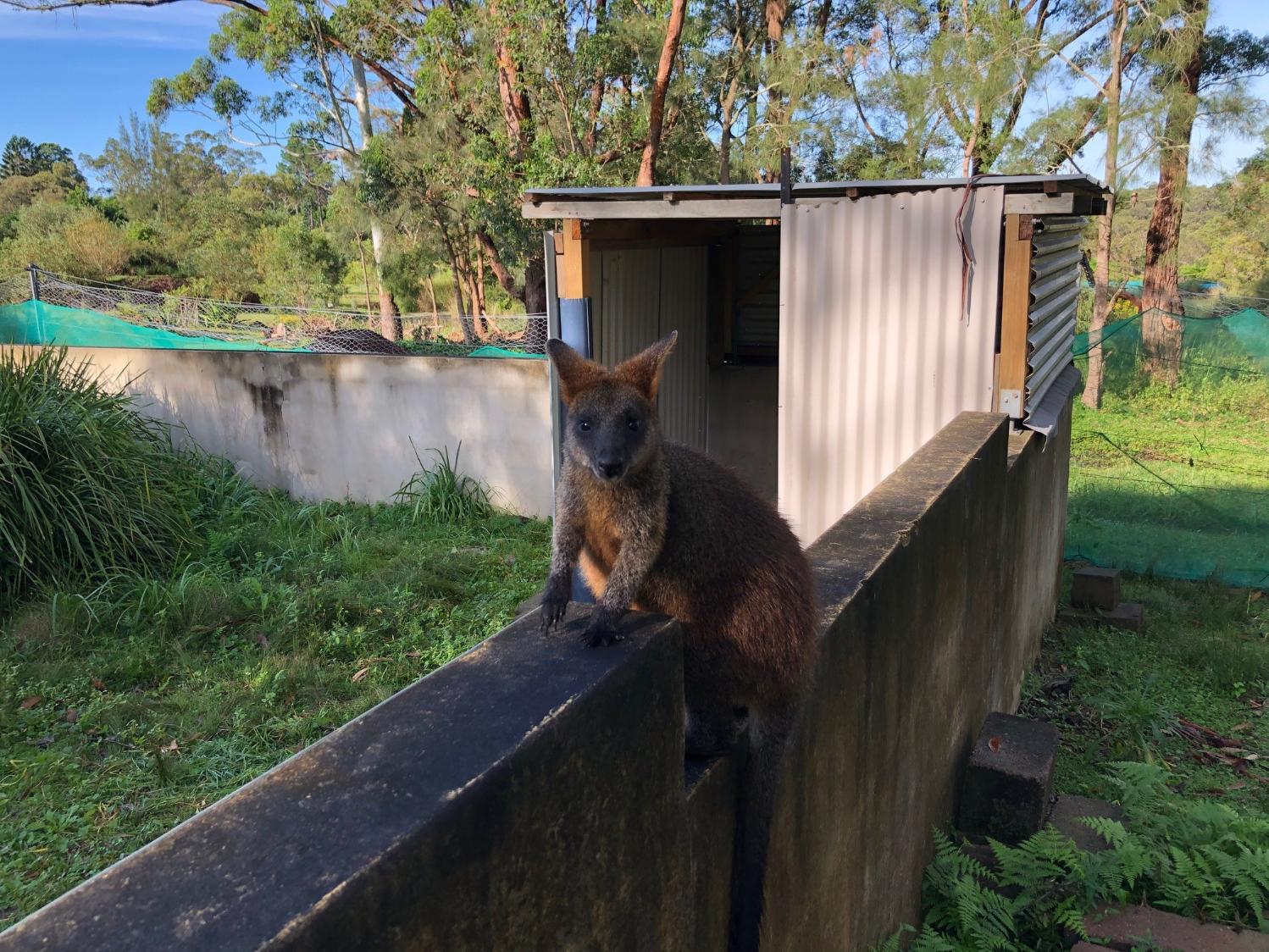
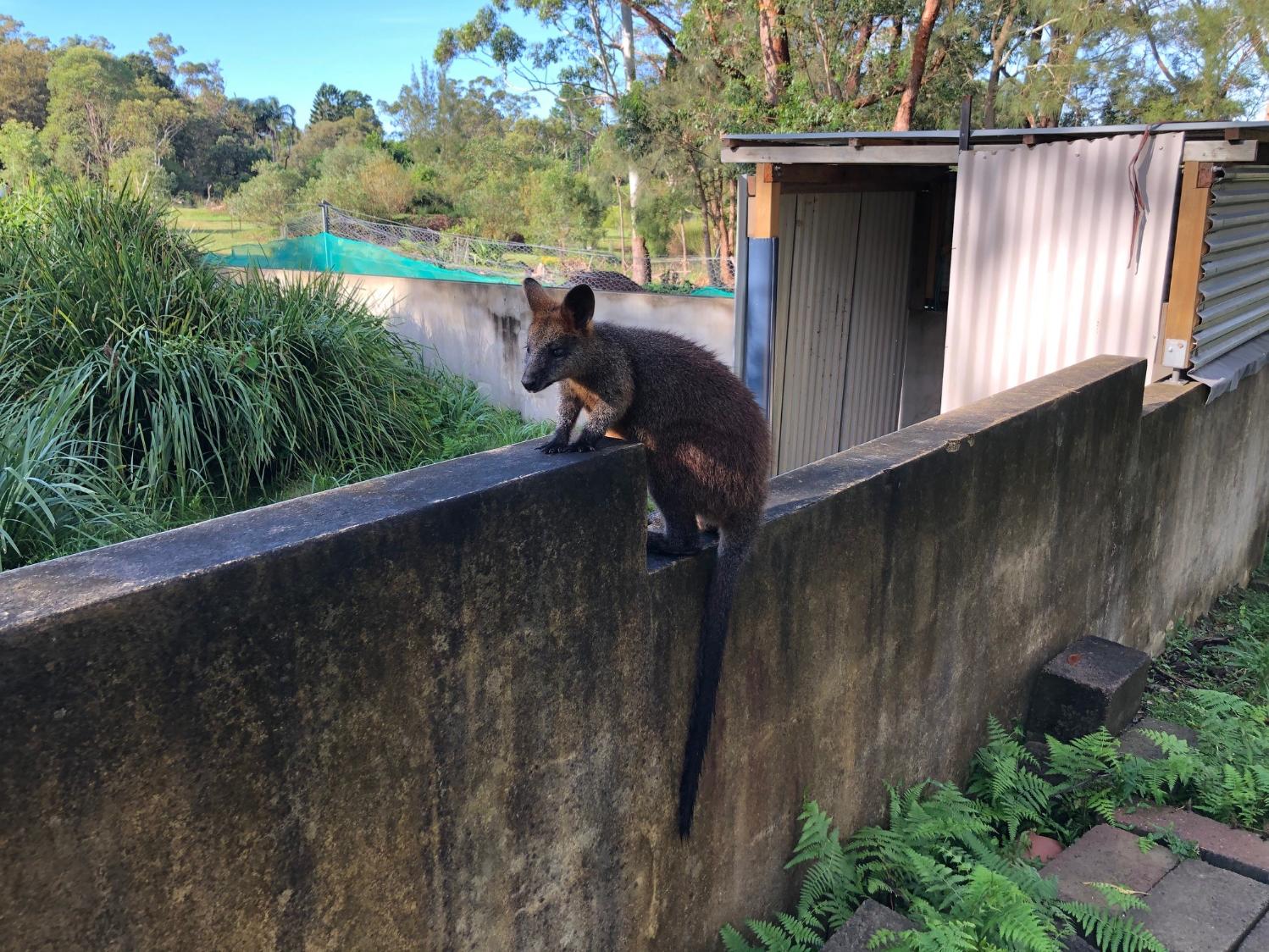
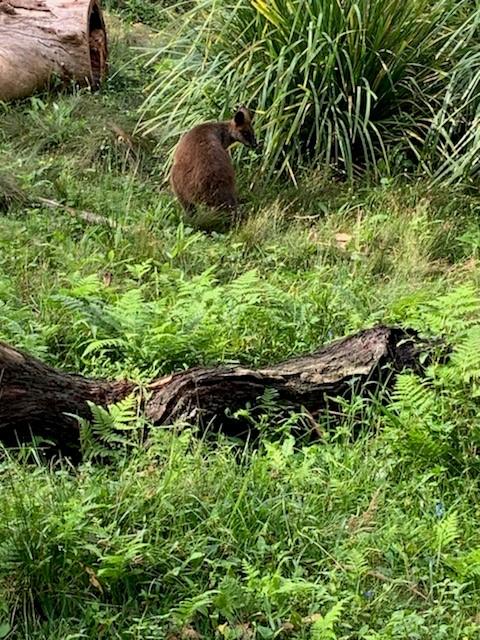
A KOOKABURRA'S OUTLOOK: 1933
Feathered Friends
Weed Cassia Now Flowering: Please Pull Out And Save Our Bush
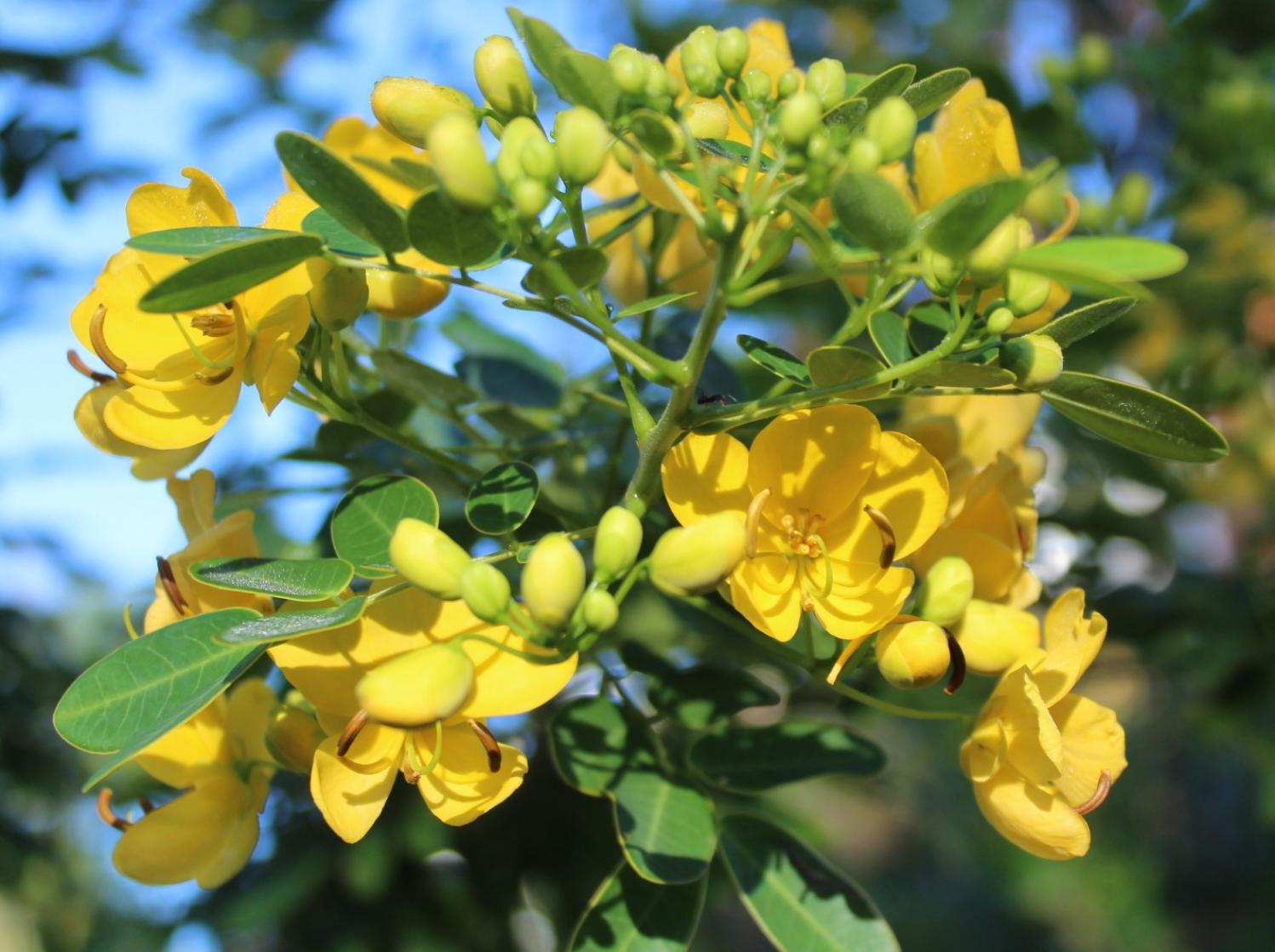
Please Help Sydney Wildlife Rescue: Donate Your Cans And Bottles And Nominate SW As Recipient
You can Help Sydney Wildlife help Wildlife. Sydney Wildlife Rescue is now listed as a charity partner on the return and earn machines in these locations:
- Pittwater RSL Mona Vale
- Northern Beaches Indoor Sports Centre NBISC Warriewood
- Woolworths Balgowlah
- Belrose Super centre
- Coles Manly Vale
- Westfield Warringah Mall
- Strathfield Council Carpark
- Paddy's Markets Flemington Homebush West
- Woolworths Homebush West
- Caltex Concord road Concord West
- Bondi Campbell pde behind Beach Pavilion
- Westfield Bondi Junction car park level 2 eastern end Woolworths side under ramp
- UNSW Kensington
- Enviro Pak McEvoy street Alexandria.
Every bottle, can, or eligible container that is returned could be 10c donated to Sydney Wildlife.
Every item returned will make a difference by removing these items from landfill and raising funds for our 100% volunteer wildlife carers. All funds raised go to support wildlife.
It is easy to DONATE, just feed the items into the machine select DONATE and choose Sydney Wildlife Rescue.
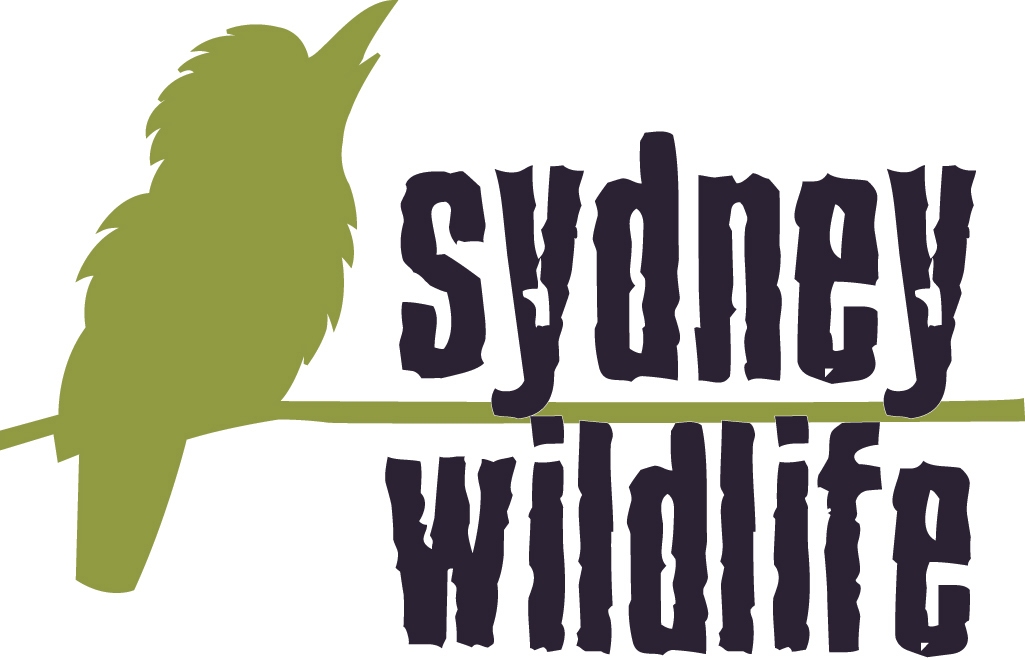
Bushcare In Pittwater
Where we work Which day What time
Avalon
Angophora Reserve 3rd Sunday 8:30 - 11:30am
Avalon Dunes 1st Sunday 8:30 - 11:30am
Avalon Golf Course 2nd Wednesday 3 - 5:30pm
Careel Creek 4th Saturday 8:30 - 11:30am
Toongari Reserve 3rd Saturday 9 - 12noon (8 - 11am in summer)
Bangalley Headland 2nd Sunday 9 to 12noon
Bayview
Winnererremy Bay 4th Sunday 9 to 12noon
Bilgola
North Bilgola Beach 3rd Monday 9 - 12noon
Algona Reserve 1st Saturday 9 - 12noon
Plateau Park 1st Friday 8:30 - 11:30am
Church Point
Browns Bay Reserve 1st Tuesday 9 - 12noon
McCarrs Creek Reserve Contact Bushcare Officer To be confirmed
Clareville
Old Wharf Reserve 3rd Saturday 8 - 11am
Elanora
Kundibah Reserve 4th Sunday 8:30 - 11:30am
 Mona Vale
Mona Vale Mona Vale Beach Basin 1st Saturday 8 - 11am
Mona Vale Dunes 2nd Saturday +3rd Thursday 8:30 - 11:30am
Newport
Bungan Beach 4th Sunday 9 - 12noon
Crescent Reserve 3rd Sunday 9 - 12noon
North Newport Beach 4th Saturday 8:30 - 11:30am
Porter Reserve 2nd Saturday 8 - 11am
North Narrabeen
Irrawong Reserve 2nd Saturday 2 - 5pm
Palm Beach
North Palm Beach Dunes 3rd Saturday 9 - 12noon
Scotland Island
Catherine Park 2nd Sunday 10 - 12:30pm
Elizabeth Park 1st Saturday 9 - 12noon
Pathilda Reserve 3rd Saturday 9 - 12noon
Warriewood
Warriewood Wetlands 1st Sunday 8:30 - 11:30am
Whale Beach
Norma Park 1st Friday 9 - 12noon
Western Foreshores
Coopers Point, Elvina Bay 2nd Sunday 10 - 1pm
Rocky Point, Elvina Bay 1st Monday 9 - 12noon
Gardens And Environment Groups And Organisations In Pittwater
Pittwater Reserves
Aussie Bread Tags Collection Points

HSC Changes Protect Health And Safety Of Students
- give Principals and system authorities the power to determine the number, type and weighting of tasks for Year 11 school based assessment, in line with the decision communicated last week for HSC students
- lift the requirement for VET students to undertake NESA work placements
- cancel mandatory group performance exam in Drama and the mandatory ensemble performance exam in Music Extension.
- modify other performance exams that breach social distancing requirements.
Studying A Uni Course Online? Here Are 4 Tips To Get Yourself Tech Ready
March 30, 2020
by Mahmoud Elkhodr, Lecturer in Information and Communication Technologies, CQUniversity Australia
Belal Alsinglawi, PhD Candidate in Data Science and ICT Lecturer, Western Sydney University
Omar Mubin, Senior Lecturer in human-centred computing & human-computer interaction, Western Sydney University
Australian universities have responded in a number of ways to help prevent the spread of COVID-19. These include delaying enrolments, moving semester breaks forward, abolishing late payment fees and moving courses online.
Engaging students in online content is easier said than done. Research shows results can improve with the use of techniques such as shortening content and making it more focused, and establishing rapport between the lecturer and students.
Students’ views on online learning can be mixed. Some research shows they can find online simulations such as in physics and engineering to be efficient, but say completing many online modules takes too long.
If you’ve found yourself having to study your university course online, here are some ways to ensure you’re ready for your virtual experience.
1. Laptop and software
It goes without saying that, to learn online, you need a laptop or a desktop PC with a reliable internet connection. You will need this to participate in the virtual class, for writing essays and other assignments, and navigating your university’s learning management system – such as Moodle or Blackboard.
Connecting your phone’s earphones to your computer is perhaps the cheapest alternative to a speaker and microphone.
You might see advertisements for a webcam with a fancy 4K definition. While this will provide a high quality video, you are unlikely to need this to participate in your online class. A high resolution camera uses a lot of data and requires a high speed internet connection.
So it’s advisable to use a webcam with no more than 720p resolution to reduce the amount of bandwidth you use (to use less of your data). Most laptops’ webcams have a resolution of 720p.
You can check the resolution of your webcam here.
If you do not have access to a computer at home, you can check with your university library about borrowing a laptop. Many universities loan laptops as part of their student services. But this may be as hard as getting your hands on a roll of a toilet paper. So put your request in early.
If you need access to a specific software, such as the Microsoft Office package, you should also check with your university library if it provides a free login for students to use the software. All Australian university and school students have free access to the Microsoft Office package, but there may be others your university has signed up to.
2. Make sure you know how much data you’re using
Most Australian universities are running their virtual classes via Zoom video conferencing software. By now you would have received instructions on how to download and set up your Zoom account.
But it’s important to know how much data you will need and whether your internet speed is enough.
A typical one hour 720p video call would use almost 540MB of data download (data received) and the same for upload (data you sent). This means, on average, total data use per hour may be more than 1GB.
Netflix, in comparison, uses 1GB per hour for standard definition, and 3GB per hour for HD streaming.
Assuming you are enrolled in four units this semester, you may need to attend up to eight hours of lectures and eight hours of tutorials per week. This brings your consumption to a rough average of 16GB per week. You will also need to account for browsing and other general use.
Below are some extra tips for improving the quality of your video call.
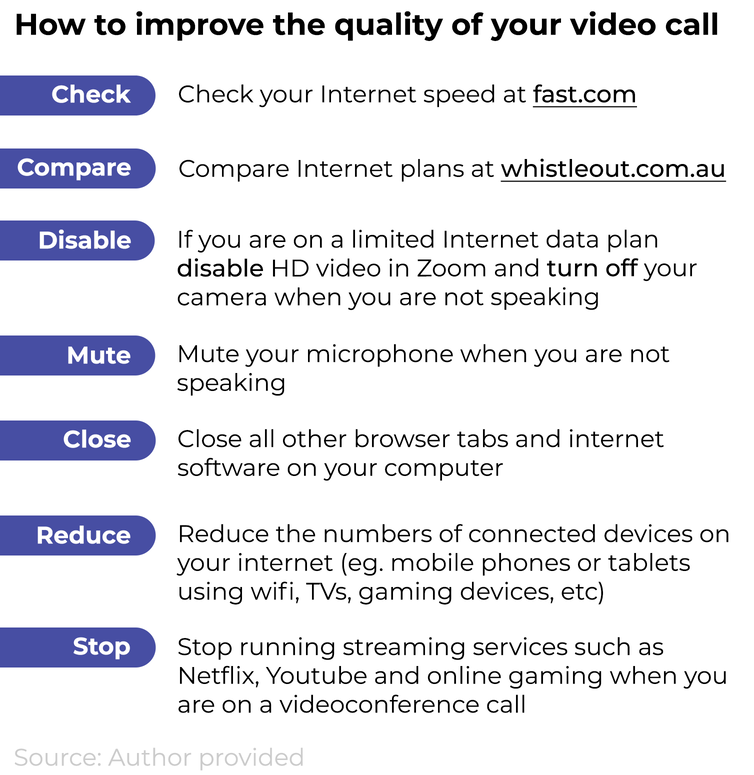
3. Set yourself up with a university VPN
Many universities provide staff and students with a Virtual Private Network (VPN), to access the university’s services when off campus.
If you are overseas, this may be essential. A VPN gives students and staff secure access to the university network. When you install the university VPN client on your computer, it will create a kind of a secure, private “tunnel” so the data exchanged between your computer and the university network won’t be seen by other internet users.
Some universities have set up a VPN specifically to help students in China impacted by the COVID-19 travel restrictions.
Regardless of your location, accessing university services (e-learning platform such as Moodle, Blackboard, special software and journals) via VPN will simplify many of the security and access control policies enforced by your university such as dual and two- factor authentication.
Accessing the university library website via VPN will also give you free access to many paid research databases. As with any networking resource, if multiple students are accessing it at the same time, there is a chance of congestion.
For information on how to set up a VPN connection on your computer, consult your university library or IT support department.
4. Abide by some basic etiquette rules
A final point to remember is though you are attending classes from home, this doesn’t mean you should behave as if at home. An online classroom is a professional environment.
There are some basic etiquette rules for online learning, which include:
- be on time for class. Try to login five minutes before so you can make sure your audio, video and other features are set up
- wear the kind of clothes you would wear to class. Just because it’s virtual, doesn’t mean you can be in bed while Zooming in
- mute your microphone when others are speaking
- try to reduce your movements when your camera is turned on
- don’t assume people will remember your name and introduce yourself when you speak
- don’t shout over, or interrupt, others who are speaking.
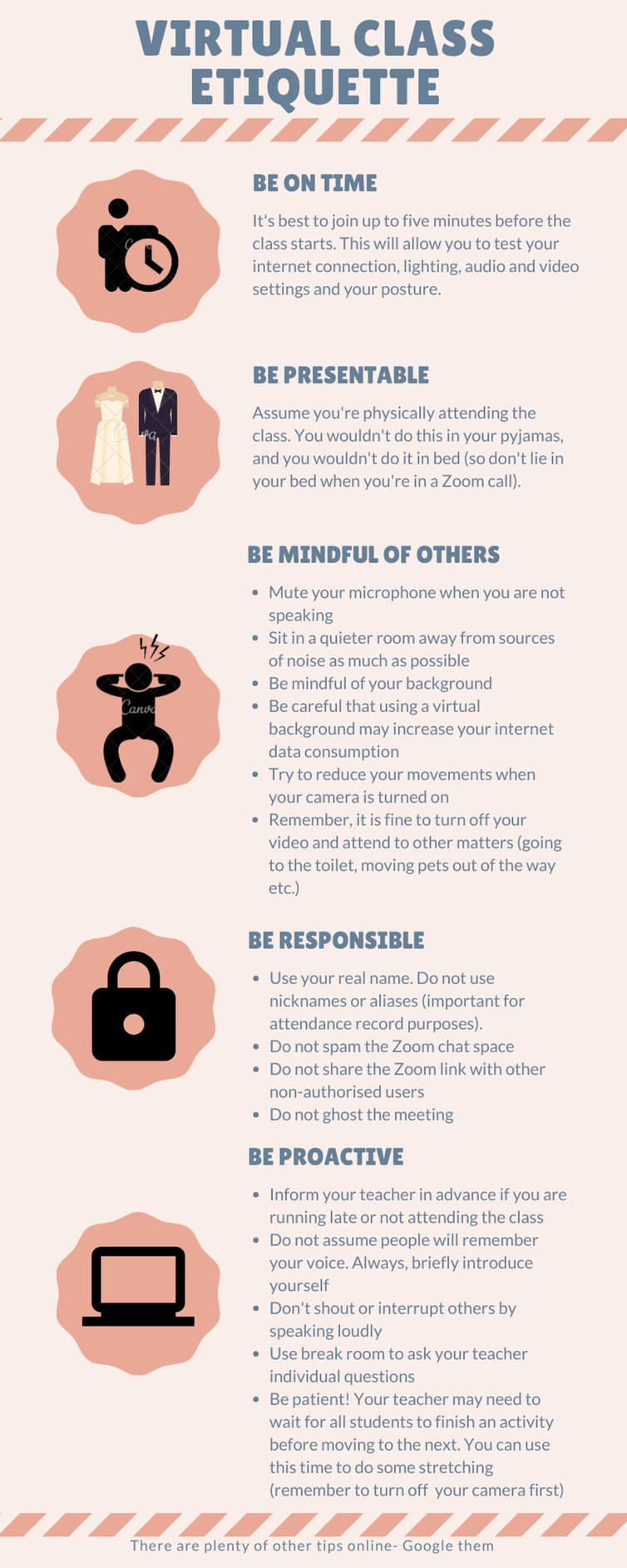
The 2020 CWAS "David Malin Awards" Are Now Open For Entries: New Astrophotgraphy With Your Smartphone This Year
Proudly supported by CSIRO's Astronomy and Space Sciences, The Museum of Applied Arts and Sciences and Canon Australia.
The Central West Astronomical Society is proud to announce the 2020 CWAS Astrophotography Awards judged by Dr David Malin - the "David Malin Awards".
Click here to see the Conditions of Entry.
This year's competition continues to build on the experience of previous years to help make it the premier competition of its kind in Australia. The competition this year will have three sections of entry - General Section, Open Themed Section and a Junior Section (18 or younger). The general section is divided into five categories; Wide-field (camera shots), Deep Sky (telescope shots), Solar System, Nightscapes and Animated Sequences. The Animated Sequences category has two subsections - Scientific and Aesthetic. The Junior Section will have one open category and entries can be of any astronomical subject, and can be an animated sequence.
The Competition Structure:
General Section:
- Wide-Field
- Deep Sky
- Solar System
- Nightscapes
- Animated Sequences
- Scientific
- Aesthetic
- Junior Section (18 or younger) - One Open Category (can be of any astronomical subject)
- Open Themed Section - "Astrophotography with your Smartphone"
- The "David Malin Innovation Prize" may be awarded, at Dr Malin's discretion, for a striking astronomical image that shows exceptional imagination, innovation or an unusual approach in any of the categories.
- An additional prize, "The Photo Editor's Choice", will also be awarded. This will be judged by a major news organisation's photo editor or editors.
The Solar System category is for images of solar system objects taken with a telescope. Wide-field solar system shots may be entered in the Wide-Field or Nightscape categories depending on the subject and composition.
The Nightscapes is intended to showcase the increasing popularity and evolution of this relatively new genre of astrophotography, combining beautiful terrestrial foregrounds with a night sky scene - often in a single exposure (HDR is OK) or as a multi-shot panorama.
Animated Sequences should be videos that are intriguing or highlight concepts and events not obvious or significant in stills. Astrophotographers are invited to submit animations, produced as either time-lapse sequences or with other forms of video. They can be of any subject, provided there is a distinct astronomical link. This category will have two subsections - Scientific and Aethestic. Scientific animations are short sequences that have an obvious scientific purpose, perhaps changes in the appearance of a planet, comet or other celestial body, or where the footage was used for the timing of a transit, an occultation, or even in studying dome seeing. These sequences usually require great skill and/or perseverance in first obtaining the data and then in collating them to reveal an aspect of scientific merit. Aesthetic sequences are animations that are aesthetically pleasing in some way, where the use of appropriate music and editing is encouraged, but always with a strong astronomical component. Scientific animations should be silent and be less than one minute in duration. Aesthetic animations must not exceed two minutes in runtime. All animations must be submitted as MOV, MPEG, AVI or MP4 files.
The Open Themed Section is open to all astrophotographers. They are encouraged to see who can be the most inventive and creative in evoking the theme, which this year will be "Astrophotography with your Smartphone". Smart phones are everywhere and some are capable of impressive low light-level photography. We are looking for images that have been taken with a smartphone of an astronomical scene that has some aesthetic appeal and/or that has captured something you might not expect to see from such a tiny camera.
All entries must be images that faithfully reflect and maintain the integrity of the subject. Entries made up of composite images taken at different times, different locations or with different cameras are not acceptable. Image manipulations that produce works that are more "digital art" than true astronomical images, will be deemed ineligible.
All still images must be submitted as digital files via a dedicated web site that can be accessed at this web address. For judging purposes, still images must be submitted as JPG files with the longest side having a dimension no greater than 4,950 pixels. All images must be in Adobe 1998 RGB colour space and will be judged using a calibrated monitor. Similarly, winning images will be printed from the files as-received, so it would be prudent for entrants to calibrate their monitors if possible. It does make a difference. Click here for an example of a very detailed set of calibration procedures for all platforms. For Mac users, a useful monitor calibration program can be found under "Monitors" in System Preferences, and the ideal solution for monitor calibration is a stand-alone device such as the Spyderexpress.
Submission of entries will be accepted from Wednesday, 1 April 2020, and will close at 24:00 (AEST) on Tuesday, 30 June 2020. Entrants must register in advance. This can be done from 1 April from the Submit Entries link on this page.
Entry payments can be made by cheque, money order or direct deposit. For the entries to be accepted, the payments must be received by the deadline. Entry fees are $15 per entry. Payment details will be presented following each entry submission.
The photographs will be judged by world-renowned astrophotographer, Dr David Malin. During the course of the judging process, Dr Malin may invite, at his discretion, the views of other distinguished international astronomers to aid him in his deliberations, with Dr Malin's decisions being final.
All entries will be judged without David being aware of the identity of the photographer, and to preserve anonymity, the submitted image files should not contain identifying metadata. The winners will be notified and presented with the "David Malin Awards" during a special ceremony at the CSIRO Parkes Observatory in the presence of invited dignitaries on a date to be announced. All winners are required to make every effort to attend the presentation of the awards.
A selection of the finest astrophotographs received will be professionally printed courtesy of Canon Australia by Sunstudios and exhibited for the entire year at the CSIRO Parkes Observatory's Visitors Centre. In addition, a second set will tour the country in a travelling exhibition, organised by the Museum of Applied Arts and Sciences, to selected venues beginning with Sydney Observatory.
There is a limit of five (5) entries per category per photographer. All photographs must have been taken no more than 2 years before the closing date of entry, and no re-entries from previous DMA competitions will be accepted. All entries must be submitted in electronic form via the dedicated submissions web site. The entrants must provide brief details of the equipment, exposure times, processing and, where relevant, the location where the image was taken.
It is not just technical skill that David Malin will be looking for, but an aesthetically pleasing picture that reflects and captures the beauty, inspiration and interest of astronomy. All images will be judged by these criteria.
Canon Australia is supporting the competition with significant prizes.
Finals Judge: Dr David Malin
Presentation Ceremony for the 2020 CWAS "David Malin Awards" to be held at the CSIRO Parkes Observatory on a date to be announced.
Entries close at 24:00 (AEST) on Tuesday, 30 June 2020.
Visit: https://www.parkes.atnf.csiro.au/news_events/astrofest/DMA/
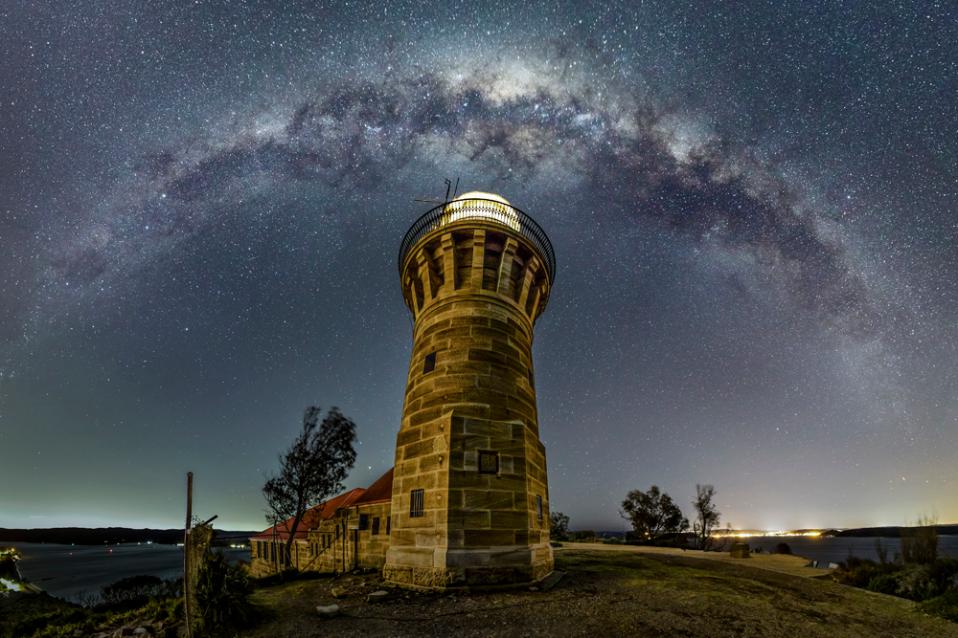
The World At Your Finger Tips: Online
With current advice to stay at home and self-isolate, when you come in out of the garden, have had your fill of watching movies and want to explore something new, there's a whole world of books you can download, films you can watch and art galleries you can stroll through - all from at home and via the internet. This week a few suggestions of some of the resources available for you to explore and enjoy. For those who have a passion for Art - this month's Artist of the Month is the Online Australian Art Galleries and State Libraries where you can see great works of art from all over the world and here - both older works and contemporary works.
Also remember the Project Gutenberg Australia - link here- has heaps of great books, not just focused on Australian subjects but fiction works by popular authors as well. Well worth a look at.
Short Stories For Teenagers You Can Read For Free Online
StoryStar is an online resource where you can access and read short stories for teenagers.
About
Storystar is a totally FREE short stories site featuring some of the best short stories online, written by/for kids, teens, and adults of all ages around the world, where short story writers are the stars, and everyone is free to shine! Storystar is dedicated to providing a free place where everyone can share their stories. Stories can entertain us, enlighten us, and change us. Our lives are full of stories; stories of joy and sorrow, triumph and tragedy, success and failure. The stories of our lives matter. Share them. Sharing stories with each other can bring us closer together and help us get to know one another better. Please invite your friends and family to visit Storystar to read, rate and share all the short stories that have been published here, and to tell their stories too.
StoryStar headquarters are located on the central Oregon coast.
Welcome To Taronga TV!
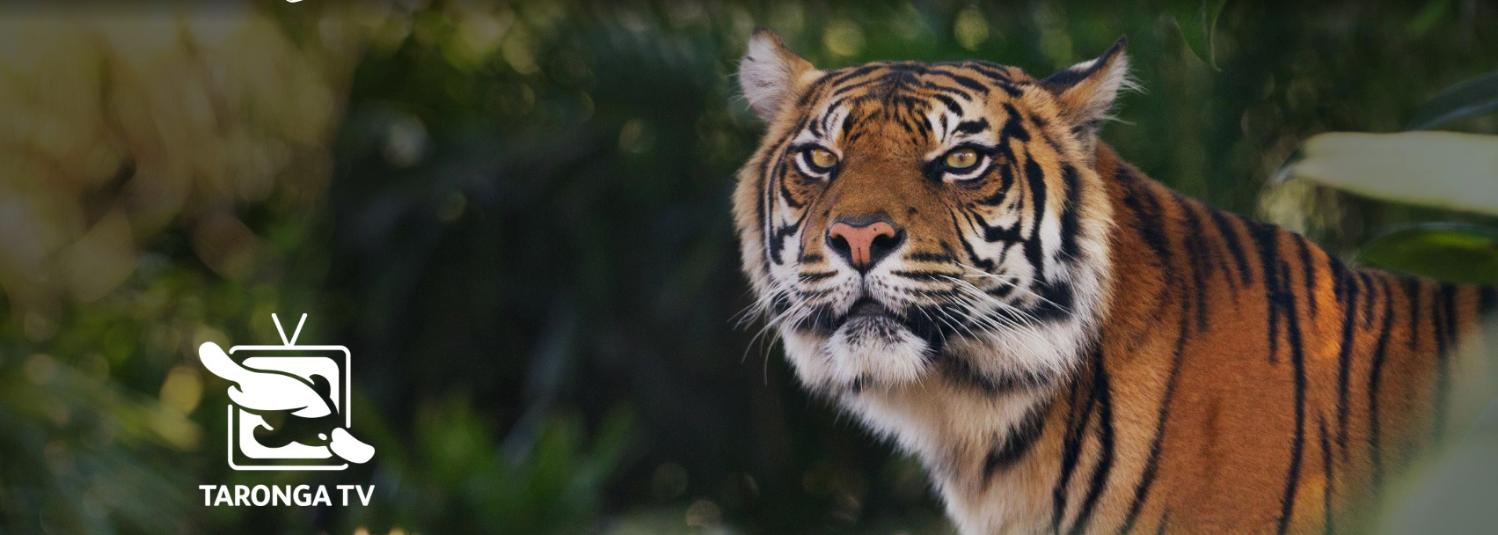
Chickens Being Live Streamed From The Manning Valley Farm
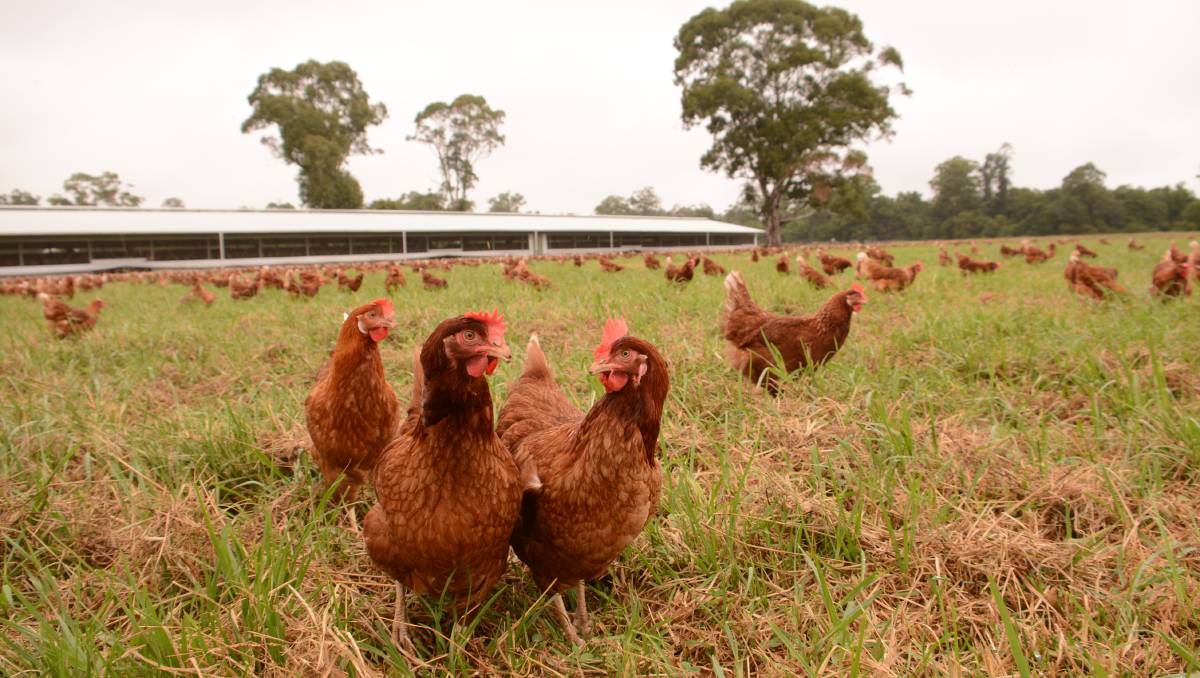
MSO Live: Stravinsky Double Bill
Premiered April 2nd, 2020
We will #KeepTheMusicGoing
Throughout the ban on public events, and where safe, the Melbourne Symphony Orchestra will continue to perform for you. Our mission is to share great music, even if you cannot join us in the concert hall.
Ensuring the health and wellbeing of MSO audiences, musicians and staff – including those integral members employed on casual and contract bases – is our priority. As a not-for-profit organisation, we are committed to ensuring the longevity and sustainability of the MSO and will continue to support workers and musicians through this uncertain period.
Thank you for your support.
Donate here: https://bit.ly/2UmDDqX
-
Hosted by MSO Cybec Assistant Conductor and Assistant Principal Cellist, Nicholas Bochner.
In this extraordinary performance, filmed live at Hamer Hall in 2019, Sir Andrew Davis guides the Orchestra through two of Stravinsky’s acclaimed works – one wild, riot-inducing and revolutionary, the other a lyrical, little-known masterpiece.
-
If you want to know more about the program, read our notes here: https://bit.ly/2WZAWhE
Alternatively, perfect for first-timers and families watching with kids, read our Discovery Guide to learn more about Stravinsky and the works you'll hear tonight: https://bit.ly/3dNSFic
-
Vision: Avoca Blue
Audio: ABC Classic
These performances of Perséphone by Igor Stravinsky are given by permission of Hal Leonard Australia Pty. Ltd. exclusive agent for Boosey & Hawkes Music Publishers Ltd of London.
Classic Movies Online In Full: With Six You Get Eggroll
When you want a break from checking out 'what's trending' on you tube, enter the search term 'complete movie HD classics' and watch the great old films by such directors as Hitchcock. There are a lot out there and even though the quality may not always be 'HD' (as they weren't made that way) you can still enjoy some funny insights and see some great fashions - many of which reappear!
A great way to spend rainy afternoons when you want a break from curling up with a good book.
An example from 1968:
MOVIE SYNOPSIS
Abby McClure (Doris Day) starts dating Jake Iverson (Brian Keith), and soon they're planning a wedding. But the relationship is complicated, as widow Abby's three sons clash with the daughter Jake fathered with his late wife. One night, a misunderstanding lands Abby in jail, and when the four children learn of the incident, they help Jake bring her home. Though they wouldn't have planned it this way, these new family members just might be getting over their growing pains.
Cast: Doris Day, Brian Keith, Barbara Hershey
Released: August 7, 1968
Learn Something New: Australia MOOCs And Free Online Courses
NFSA - National Film And Sound Archive Of Australia
The doors may be temporarily closed but when it comes to the NFSA, we are always open online. We have content for Kids, Animal Lovers, Music fans, Film buffs & lots more.
You can explore what’s available online at the NFSA, see more in the link below.
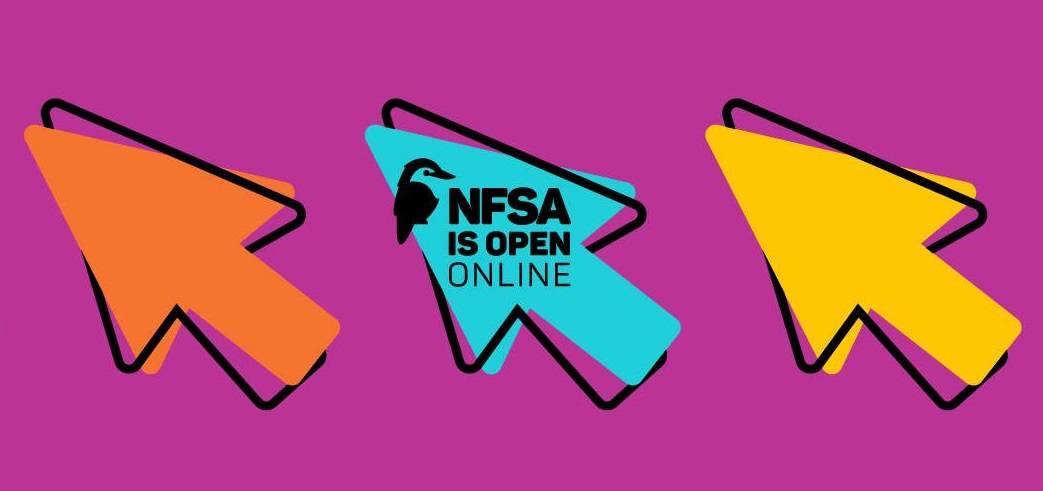
NLA Ebooks - Free To Download
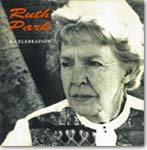 The National Library of Australia provides access to thousands of ebooks through its website, catalogue and eResources service. These include our own publications and digitised historical books from our collections as well as subscriptions to collections such as Chinese eResources, Early English Books Online and Ebsco ebooks.
The National Library of Australia provides access to thousands of ebooks through its website, catalogue and eResources service. These include our own publications and digitised historical books from our collections as well as subscriptions to collections such as Chinese eResources, Early English Books Online and Ebsco ebooks.The Internet Archive And Digital Library
The Internet Archive is an American digital library with the stated mission of "universal access to all knowledge." It provides free public access to collections of digitised materials, including websites, software applications/games, music, movies, videos, moving images, and millions of public-domain books. There's lots of Australian materials amongst the millions of works on offer.
Visit: https://archive.org/

Seniors, People With Disability And Carers Dedicated Page With All Info.
Ensuring Continued Access To Medicines During The COVID-19 Pandemic
- Continued dispensing arrangements for the ongoing supply PBS subsidised medicines without a prescription will be extended to 30 June 2020.
- A home delivery service for PBS and Repatriation Pharmaceutical Benefits Scheme (RPBS) medicines is now in place.
- Ongoing work with pharmacists, GPs and the States and Territories to allow medicine substitution by the pharmacist in the event of a shortage.
- Restrictions on the quantity of medicines that can be purchased to prevent unnecessary medicine stockpiling.
Flu Vaccination More Important Than Ever During The Month Of April
- pregnant women at any stage of pregnancy;
- all Aboriginal and Torres Strait Islander people aged six months and older;
- people aged 65 years and older;
- people aged six months and older with certain medical risk factors; and
- for the first time, all children aged between six months and five years.
- People in mandatory self-isolation due to a suspected or confirmed case of COVID -19 should remain in isolation and should not leave their home to go and get a flu vaccination.
- People who do not have COVID-19, or who are not a suspected case of COVID-19, are allowed to leave their home for a flu vaccination, but it is recommended they should only do so if they have phoned ahead, made sure their health care professional has vaccine available, and made an appointment with their healthcare professional.
- practising good hygiene
- practising social distancing
- following the Government’s directions on public gatherings and workplaces, and
- understanding how and when to self-isolate.
How To Help Your Relatives Stay Connected Online During COVID-19
Keto Diet Showing Promise
Worldwide Scientific Collaboration Unveils Genetic Architecture Of Grey Matter
- Some genetic variants are associated with cortical folding, measured as surface area, while other genetic variants are associated with the thickness of the cortex.
- Genes that determine surface area are related to very early development in the fetal cortex, while thickness appears to be driven by genes active in the adult cortex.
- People at genetic risk for depression or insomnia are genetically inclined toward having lower surface area, while people with a genetic risk for Parkinson's disease tend to have higher surface area.
- The vast scale of the project allowed the discovery of specific genes that drive brain development and aging in people worldwide.
Self-Care In The Time Of COVID-19: Creative Ways Forward
- Be mindful of what you consume and take a break from continuous news. Read, watch, listen to and eat things that help and sustain you, which nourish and bring in energy. When was the last time you listened to an album? And did nothing else? Try it!
- If anxiety or fear comes up, recognise this as a signal. After acknowledging it, do something to help calm your system. Then reappraise. A helpful hint here is that if you are really scared and panicking, it is very challenging to do mindfulness of breath. Match your calming and soothing response to the level of intensity of the emotion-try star jumps, running on the spot or jumping on a trampoline if you have one before moving to a slower, more mindful activity like yoga and mindfulness of breath.
- Reframe your negative emotions and thoughts, looking for opportunities for positive change and gratitude for the little things. Enjoy the sensory experiences we rarely stop to appreciate-how the wind moves the trees, the light in the evening, the taste and smell of coffee. The more we notice these small things, the more hope and positivity we can generate.
- While we observe social distancing or quarantine, and with gyms closed, exercise is hard-but so important for our physical and mental health. Find a new exercise routine, supported by videos, apps as well as outdoor activities at a safe distance from others. Like me, you could dance at home like no one is watching (at the moment, my family are busting moves to Shiny Happy People).
- Connect with others in the ways that you can. Reach out and phone, or text or videoconference. We can bring the world to us, even if we keep our distance.
Lessons Of The Epidemic For Small Government
Macquarie University Partners With Love Your Sister
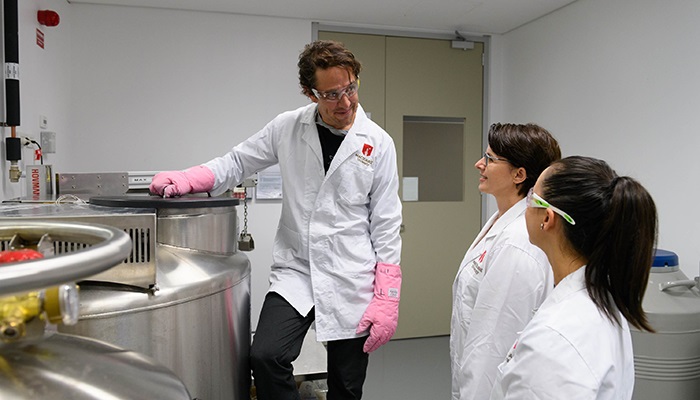
Mixed News For Women When It Comes To Radiotherapy: Worse Side Effects But More Likely To Be Cured
Disclaimer: These articles are not intended to provide medical advice, diagnosis or treatment. Views expressed here do not necessarily reflect those of Pittwater Online News or its staff.